Самый популярный аромат в мире носит простое название, даже не требующее перевода. То же самое мы говорим и о содержимом лаконичного флакона вне времени — невыразимое сочетание нот будто бы повторяет фразу Коко: «Они пахнут женщиной». В честь 100-летнего юбилея рассказываем, как Chanel №5 стал революцией в мире парфюмерии и какие великие женщины воплощали собой эстетику аромата в рекламных кампаниях.

Как создавался аромат
В 1921 году Габриэль Шанель и парфюмер Эрнест Бо подарили миру новый аромат под номером пять. Родился он в лаборатории Бо на Лазурном Берегу, в Грасе — обители парфюмерии того времени.
Но идея создания первого аромата Дома появилась еще раньше на юге Франции — в Монте-Карло, где Шанель отдыхала с русским князем Дмитрием, племянником Николая II. Тогда решение выпустить собственные духи не казалось таким логичным, как в наше время: в начале века парфюмерия была далека от моды и четко отделялась от нее как совершенно иное ремесло.
Именно князь Дмитрий познакомил Габриэль с сыном бывших парфюмеров русского царского двора Эрнестом Бо, который с 17 лет был приставлен к Ралле — первому французскому парфюмеру в России.
Композиция аромата
Вопреки моде на ароматы того времени, где за основу брали запах одного цветка, Шанель просит придумать сложную композицию, которая напоминала бы платье, созданное из множества деталей.
Так и появилась новаторская пирамида аромата: в ничем не украшенном флаконе смешалось сразу 80 элементов, часть из которых держится в строжайшем секрете и по сей день. К нотам майской розы, жасмина (он появился в композиции по пожеланию Коко), иланг-иланга и сандала были добавлены альдегиды, с которыми долго экспериментировал Бо. Благодаря этим летучим синтетическим соединениям цветочные ноты стали более легкими и воздушными по звучанию. Их впервые в истории использовали в такой большой концентрации — именно этот шаг в современность принес славу парфюмерному Дому и задал планку всем дальнейшим ароматам марки.
По словам парфюмера, на создание образцов его вдохновил полярный круг, утонченная северная красота которого не поддается разгадке.
Шанель выбрала пятый по счету аромат из представленных — так цифра стала ее талисманом на долгие годы. В счастливую дату она чаще всего назначала показы: коллекции традиционно были представлены пятого февраля или пятого августа.
В 1986 году Жак Польж создал парфюмированную воду Chanel №5, которая переосмысляет оригинал на новый лад, но сохраняет самое главное — его загадочную сложность.
Известно, что верхние ноты образуют фирменные альдегиды, экзотический цветок иланг-иланга с Коморских островов и нероли из Граса. Ноты сердца по-прежнему принадлежат грасскому жасмину и майской розе, выращенной специально для Chanel. А за мягкий и глубокий шлейф отвечают ваниль с острова Реюньон и сандал. Над десятками остальных компонентов приходится только гадать самым взыскательным «носам».
Рекламные кампании Chanel №5
Еще не успев стать мировой классикой, аромат пользовался особой популярностью в Америке, а затем плавно «перекочевал» в Азию. Молва о нем разошлась по всему миру так быстро, что во время освобождения Парижа во Вторую мировую войну улицу Камбон заполонили десятки солдат — все они стояли в очередях к бутику, чтобы привезти своим любимым заветный флакон.
Позднее парфюмерный Дом обращался к женщинам всего мира, чтобы те воплощали собой идею женственности и силы в рекламных кампаниях №5.
В 1937 году лицом аромата стала сама Шанель. Она не только бросила вызов парфюмерам, посягнув на их территорию, но и сама позировала для рекламы новинки в номере отеля Ritz.
Photo François Kollar ©Ministère de la Culture — Médiathèque du Patrimoine, Dist. RMN
1954 год ознаменован Мэрилин Монро, которая увековечила аромат в своей знаменитой цитате. Тогда на вопрос журналиста о том, что она надевает на ночь, Монро ответила: «Лишь несколько капель №5». После этого флакон стал прочно ассоциироваться с кинодивой, а продажи тут же взлетели до небес. Но актриса при жизни так и не стала лицом Chanel — только в 2013 году вышла реклама аромата с Мэрилин как дань великой женщине, полюбившей великий аромат.
В 1959 году лицом аромата стала Сьюзи Паркер. После неофициального амбассадора Мэрилин многие актрисы мечтали представить аромат-легенду. Это и сделала модель и актриса Паркер, снявшись в рекламном видео Ричарда Аведона под запоминающимся лозунгом «Каждая живущая на земле женщина любит Chanel №5».
CHANEL/Photo by Richard Avedon
В 1971 году Катрин Денев вместе с Chanel создали одну из самых популярных реклам того времени. На постере никаких лозунгов — намного красноречивее говорят об аромате портрет актрисы и прозрачный флакон. Немалую роль сыграла и сама фотография Денев работы Ричарда Аведона: она придала аромату еще большей изысканности на годы вперед.
CHANEL/Photo by Richard Avedon
В 2004 году чести прикоснуться к французской легенде удостоилась голливудская актриса Николь Кидман. Кстати, трехминутная реклама с ее участием чем-то напоминает блокбастеры, в которых привыкла сниматься Николь, — Баз Лурман снял ее за 42 миллиона долларов. Этот ролик и на сегодняшний день считается одним из самых дорогих за всю историю рекламной индустрии.
CHANEL/Photo by Patrick Demarchelier
В 2009-м аромат рекламирует Одри Тоту, что неудивительно: в этом же году она сыграла создательницу №5 в картине «Коко до Шанель». В рекламном ролике актриса играет саму себя в объективе База Лурмана, повторяя успех прошлой рекламы, — нуаровое видео с налетом эстетики фильма «Амели» надолго становится классикой парфюмерной рекламы.
CHANEL/Photo by Dominique Issermann
В 2014-м и 2016-м лицами аромата успели побывать модели Жизель Бюндхен и Лили-Роуз Депп. Представляя собой два разных поколения, они демонстрируют силу аромата: он вне возраста, времени и места — подходит абсолютно каждой женщине, осмелившейся его носить.
В 2020-м Chanel объявил, что новым лицом №5 стала французская актриса Марион Котийяр. Она словно магнитом притягивает к себе экранные образы, которые невозможно забыть. Одним из таких стала новая роль актрисы в рекламной кампании главного женского аромата на протяжении почти 100 лет.
Режиссер Юхан Ренк исполняет мечту Марион и отправляет ее на Луну с флаконом в руках. Переливающийся золотой наряд на актрисе — новая интерпретация платья, которое носила сама Габриэль Шанель. Оно перекликается с лунной поверхностью и отражается в звездах вокруг, на фоне которых и происходит завораживающий танец двух влюбленных. Судя по накалу эмоций, это была их мечта — перенестись сюда только вдвоем в густом облаке аромата.
Кстати, красивый танец с мужчиной мечты актриса репетировала ровно пять дней — эта магия вокруг счастливой цифры определенно понравилась бы самой Коко, которая верила в знаки.
Марион признается, что с подросткового возраста мечтала стать той женщиной, для которой был создан аромат №5, что и случилось с выходом новой рекламной кампании в честь 100-летия легендарного парфюма. Советуем и вам поступить как великая французская актриса, а именно — нанести на тело пару капель под номером пять и во что бы то ни стало осуществить свою заветную мечту.
Марион Котийяр для Chanel
На сайте могут фигурировать ссылки на внешние ресурсы, которые мы не администрируем и не контролируем. Политика конфиденциальности, практикуемая другими сайтами, не находится в сфере нашего влияния. Как только вы осуществляете переход на другие ресурсы, вы должны найти информацию об их политике конфиденциальности, прежде чем вводить на них свои данные.
Легендарные духи Chanel №5 отмечают столетие: 5 мая 1921 года Габриэль Шанель познакомила с ними парижский высший свет. Аромат стал новой страницей в истории парфюмерии, а создал его Эрнест Бо, парфюмер французского происхождения родом из России. Он воплотил в Chanel №5 свои воспоминания о покинутой навсегда стране. «Газета.Ru» — о том, как связаны Chanel №5, холодные озера Кольского полуострова и утраченные духи «Букет Екатерины», созданные на фабрике A. Rallet & Co., которая после революции получила название «Свобода».
Духам Chanel №5 исполняется сто лет. 5 мая 1921 года парижский модельер Габриэль «Коко» Шанель, представляя в своем ателье на Рю Камбон новую коллекцию одежды, распылила в примерочных необыкновенный аромат, глубокий, бархатистый, цветочный — и в то же время морозно свежий. Так парижский высший свет познакомился с духами, которые она назвала своим именем. Подруга Габриэль Шанель, Мисиа Серт, позже сказала: «Это было все равно что вытянуть счастливый лотерейный билет». Chanel №5 были обречены на успех, хотя в широкую продажу поступили лишь через несколько лет, а первая партия составила всего 100 флаконов.
Автором аромата был Эрнест Бо, парфюмер французского происхождения родом из России. Когда-то он создавал парфюмерные композиции для фабрики A. Rallet & Co., поставщика российского Императорского двора. В 1912 году, например, популярность получил придуманный им к столетию Бородинского сражения аромат «Bouquet de Napoleon» («Букет Наполеона»). Коко Шанель познакомилась с парфюмером в 1920 году, когда отдыхала на Лазурном берегу в компании своего возлюбленного, племянника русского императора Николая II великого князя Дмитрия Павловича.
У Габриэль Шанель была идея выпустить именной аромат, который «пахнет как женщина, а не как роза». Эрнест Бо согласился исполнить это желание и представил ей ряд флаконов, пронумерованных числами от 1 до 5 и от 20 до 24. Она выбрала пятый, заявив: «Я представляю свои коллекции 5 мая, в пятый месяц года, так что давайте оставим номер, который он носит, и пусть он принесет ему удачу». Формула аромата, которая до сих пор хранится в секрете, содержала 80 натуральных и синтетических компонентов, а парфюмерная композиция выстраивалась из сочетания запахов майской розы, иланг-иланга, жасмина, ветивера, ириса, ванили — и все это было приправлено щедрой дозой альдегидов,
синтетического вещества, которое придает духам морозный запах чистоты и свежести.
В начале ХХ века модельеры и парфюмеры существовали раздельно — кутюрье не занимались выпуском духов. Женщины из высшего общества пользовались духами с ароматом отдельного цветка, а не сложными композициями из мускуса и жасмина. Но ни в том, ни в другом аспекте Chanel №5 не были первыми. К тому моменту модельер Поль Пуаре уже выпустил духи, которые назвал в честь своей дочери назвал Parfums de Rosine («Духи Розины»), а парфюмер Эме Герлен еще в 1889 году создал аромат Jicky, представлявший собой сложную композицию с нотами лаванды и цитрусовых, с синтетическим кумарином и другими компонентами.
Но вот флакон Chanel №5 — пузырек с притертой стеклянной пробкой, лаконичный, прямоугольный, напоминающий фляжку виски, — действительно был первым в своем роде после вычурных емкостей Lalique или Baccarat. Разливать в фирменные флаконы аромат Шанель начали в 1922 году, когда его запустили в производство. А до 1924 года Chanel №5 продавали только в парижском бутике и лишь избранным.
Сама Коко Шанель поняла, что придуманный Эрнестом Бо аромат действительно произведет революцию в парфюмерном мире, благодаря трюку. Чтобы отпраздновать создание духов, она пригласила нескольких друзей в ресторан в городе Грассе, парфюмерной столице Франции (и, пожалуй, всего мира). Во время обеда Коко Шанель внезапно разбрызгала вокруг новый аромат — и каждая женщина, которая проходила мимо, спрашивала, что это за запах.
«Это был момент, когда она поняла, что это будут революционные духи, — рассказывала историк культуры Тилар Маззео, автор книги «The Secret of Chanel No 5» («Секрет Chanel №5»), «Би-би-си». — Каждый, кто там был, вдыхал Chanel №5, и это заставляло его остановиться. Люди ощущали аромат, которого еще не было, это был исторический момент».
«Ароматы, так же, как и фильмы стоит рассматривать в контексте эпохи и их исторического значения. У Chanel №5 оно огромно, — объясняет «Газете.Ru» коллекционер и исследователь парфюмерии Галина Анни. — Эти духи послужили появлению целого класса цветочно-альдегидных ароматов, к которым относится, в частности, Arpege Lanvin 1927 года или созданные много позже и любимые советскими женщинами духи Madame Rochas и Climat Lancome. Революционный флакон также породил множество подражаний».
Чем должна была пахнуть современница Габриэль Шанель? Как полагает Тилар Маззео, ключевым был аромат чистоты, который давали альдегиды. Дело в том, что Габриэль Шанель, с 12 лет воспитывавшаяся в монастыре, а позже пользовавшаяся успехом у мужчин, была необычайно чистоплотной и не переносила запаха немытого тела. От нового аромата она ждала сочетания чувственности, которую несут ароматы жасмина и розы, и чистоты. «В альдегидах интересно, что некоторые из них пахнут мылом, — рассказывала Тилар Маззео «Би-би-си». — Так что она могла уравновесить в своей голове жизнь в монастыре и роскошную жизнь в качестве любовницы».
Для Эрнеста Бо запах альдегидов, которые в те времена парфюмеры использовали весьма осторожно, опасаясь слишком сильного аромата нового синтетического компонента, был воспоминанием о России. Точнее, о Кольском полуострове. В 1914 году после начала Первой мировой войны он отправился служить на север, а после революции в годы Гражданской войны оказался в рядах французских интервентов — в 1919 году Бо посещал лагерь военнопленных красноармейцев на острове Мудьюг в Белом море, близ Архангельска, и служил там переводчиком на допросах большевиков (в конце года он уехал во Францию).
Как писал в своих мемуарах 1965 года «Souvenirs et Parfums» («Воспоминания и духи») Константин Веригин, который долгое время был помощником парфюмера, в Chanel №5 Эрнест Эдуардович Бо пытался воссоздать аромат холодных рек озер Кольского полуострова посреди полярного дня.
О них вспоминал и сам парфюмер в одной из лекций 1946 года, когда говорил, что за Полярным кругом «реки и озера источают ноту невероятной свежести».
Правда, есть предположение, что альдегиды парфюмер использовал еще в 1913 году при создании духов Bouquet de Catherine («Букет Екатерины»), которые не сохранились. Когда в 2007 году химическому анализу подвергли сделанные Эрнестом Бо после приезда из России духи Rallet № 1, близкие к «Букету Екатерины», оказалось, что там используется большое количество альдегидов, как и в Chanel №5.
За историей создания легендарного аромата следует долгая история его жизни. В 1924 году Коко Шанель договорилась с предпринимателями, владельцами фирмы Bourjois Пьером и Полом Вертхаймерами, о том, что они возьмут на себя производство и дистрибуцию Chanel №5, основав компанию Parfums Chanel, в которой модельеру принадлежало 10%.
В годы Второй мировой войны Габриэль Шанель попыталась взять контроль над компанией — она обратилась с письмом к оккупационным властям Франции, в котором говорилось, что братья Вертхаймеры, будучи евреями, должны отдать ей Parfums Chanel.
Однако оказалось, что заблаговременно уехавшие в США предприниматели переписали фирму на француза-христианина по имени Феликс Амьо. В 1947 году братья Вертхаймеры, получившие парфюмерный дом назад, пришли к соглашению с Габриэль Шанель — с тех пор она получала 2% от продаж духов имени себя по всему миру.
Эрнест Бо оставался креативным директором Parfums Chanel с 1924 по 1954 год. А созданный им аромат и до сих пор создается вечной классикой, который остается в числе самых продаваемых ароматов в мире, в том числе, и благодаря мощной маркетинговой стратегии.
«Всегда трудно поддерживать актуальность аромата в течение десятилетий, многие шедевры прошлого давно уже забыты, но маркетинг и реклама «пятерки» всегда были выдающимися, как и ее техническая поддержка, — говорит Галина Анни. — Парфюмеры Дома – Эрнест Бо, Анри Робер, Жак Польж, Оливье Польж — уделяли огромное внимание качеству ингредиентов и очень бережно вносили в формулу изменения, которые требовало время. Chanel №5 воспринимается сейчас как воплощение роскоши и элегантности, несмотря на довольно скромную цену в сравнении со многими модными брендами. А выпуск фланкера L’Eau №5 – хорошее движение в сторону молодежной аудитории».
Не стоит забывать и о том, кто рекламировал на протяжении ста лет Chanel №5. Первым лицом аромата стала сама Коко Шанель — она появилась на рекламном плакате в Harper’s Bazaar в 1937 году. «Лицами» легендарных духов становились Катрин Денев, Кароль Буке, Николь Кидман, а в рекламе молодежного фланкера в 2016 году снялась Лили-Роуз Депп. Но все же самую незабываемую рекламу аромату сделала Мэрилин Монро, которая призналась в 1952 году, что ложась в постель, надевает только Chanel №5.
| No. 5 | |
|---|---|
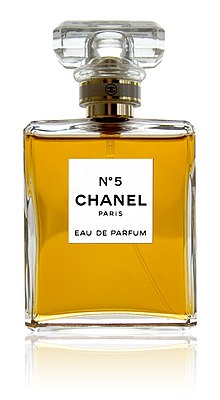 Bottle of Chanel No. 5, Eau de Parfum version | |
| Fragrance by Chanel | |
| Released | 5 May 1921, to select clientele at Chanel, rue Cambon, Paris |
| Label | Chanel |

Chanel No. 5 was the first perfume launched by French couturier Gabrielle «Coco» Chanel in 1921. The scent formula for the fragrance was compounded by French-Russian chemist and perfumer Ernest Beaux. The design of its bottle has been an important part of the product’s branding. Coco Chanel was the first face of the fragrance, appearing in the advertisement published by Harper’s Bazaar in 1937.[1]
Inspiration[edit]
Traditionally, fragrances worn by women fell into two basic categories. «Respectable women» favored the essence of a single garden flower while sexually provocative indolic perfumes heavy with animal musk or jasmine were associated with women of the demi-monde, prostitutes, or courtesans.[2]: 20 Chanel sought a new scent that would appeal to the flapper and celebrate the seemingly liberated feminine spirit of the 1920s.[citation needed]
The No. 5 name[edit]
At the age of twelve, Chanel was handed over to the care of nuns, and for the next six years spent a stark, disciplined existence in a convent orphanage, Aubazine, founded by 12th-century Cistercians[3]: 4 in the Nouvelle-Aquitaine region of central France. From her earliest days there, the number five had potent associations for her. For Chanel, the number five was especially esteemed as signifying the pure embodiment of a thing, its spirit, its mystic meaning. The paths that led Chanel to the cathedral for daily prayers were laid out in circular patterns repeating the number five.[2]: 8–9
Her affinity for the number five co-mingled with the abbey gardens, and by extension the lush surrounding hillsides abounding with Cistus (rock roses).[2]: 10
In 1920, when presented with small glass vials containing sample scents numbered 1 to 5 and 20 to 24 for her assessment, she chose the fifth vial. Chanel told her master perfumer, Ernest Beaux, whom she had commissioned to develop a new fragrance, «I present my dress collections on the fifth of May, the fifth month of the year and so we will let this sample number five keep the name it has already, it will bring good luck.»[2]: 60–61
Bottle design[edit]
Chanel envisioned a design that would be an antidote for the over-elaborate, precious fussiness of the crystal fragrance bottles then in fashion popularized by Lalique and Baccarat. Her bottle would be «pure transparency…an invisible bottle». It is generally considered that the bottle design was inspired by the rectangular beveled lines of the Charvet toiletry bottles, which, outfitted in a leather traveling case, were favored by her lover, Arthur «Boy» Capel.[4] Some say it was the whiskey decanter he used that she admired and wished to reproduce in «exquisite, expensive, delicate glass».[2]: 103
The first bottle produced in 1922, differed from the Chanel No. 5 bottle known today. The original container had small, delicate, rounded shoulders and was sold only in Chanel boutiques to select clients. In 1924, when «Parfums Chanel» incorporated, the glass proved too thin to survive shipping and distribution. The bottle was modified with square, faceted corners, its only significant design change.[2]: 104 In a 1924 marketing brochure, Parfums Chanel described the bottle as, «the perfection of the product forbids dressing it in the customary artifices. Why rely on the art of the glassmaker…Mademoiselle is proud to present simple bottles adorned only by…precious teardrops of perfume of incomparable quality, unique in composition, revealing the artistic personality of their creator.»[2] Others claim that the bottle’s design was inspired by a whiskey bottle, while some say that the inspiration was drawn from glass pharmaceutical vials. In choosing the design for her perfume’s bottle, was looking for something simple, even clinical, to stand apart from the overstated designs customarily seen on the perfume counter.[5]
Unlike the bottle, which has remained the same since the 1924 redesign, the stopper has gone through numerous modifications. The original stopper was a small glass plug. The octagonal stopper, which became a brand signature, was created in 1924, when the bottle shape was changed. The 1950s gave the stopper a bevel cut and a larger, thicker silhouette. In the 1970s the stopper became even more prominent but, in 1986, it was re-proportioned so its size was more harmonious with the scale of the bottle.[2]: 105
The «pocket flacon,» designed to be carried in a purse, was introduced in 1934. The price and container size were reduced to appeal to a broader customer base.[2]: 121
The bottle, over the decades, has itself become an identifiable cultural artifact, so much so that Andy Warhol chose to commemorate its iconic status in the mid-1980s with his pop art, silk-screened, Ads: Chanel.[2]: 199
A limited-edition, crimson red crystal glass bottle in the three editions of Chanel No. 5, namely Eau de Parfum, Parfum, and L’Eau, was launched for Christmas in 2018.[6]
Battle for control of Parfums Chanel[edit]
In 1924, Chanel made an agreement with the Wertheimer brothers, Pierre and Paul, directors of the perfume house Bourjois, creating a new corporate entity, Parfums Chanel. The Wertheimers agreed to manage production, marketing, and distribution of Chanel No. 5. The Wertheimers would receive a 70 percent share of the company, and Théophile Bader, founder of the Paris department store Galeries Lafayette, would receive 20 percent. Bader had been instrumental in brokering the business connection by introducing Chanel to Pierre Wertheimer at the Longchamps races in 1922.[7] For 10 percent of the stock, Chanel licensed her name to Parfums Chanel and removed herself from involvement in all business operations.[2]: 95 Later, unhappy with the arrangement, Chanel worked for more than twenty years to gain full control of Parfums Chanel. She said that Pierre Wertheimer was «the bandit who screwed me».[2]: 153
World War II brought with it the Nazi seizure of all Jewish-owned property and businesses, providing Chanel with the opportunity to gain control of Parfums Chanel and its most profitable product, Chanel No. 5. The Wertheimers were Jewish, and Chanel used her position as an «Aryan» to petition German officials to legalize her right to sole ownership.
On 5 May 1941, Chanel wrote to the government administrator charged with ruling on the disposition of Jewish financial assets. Her grounds for proprietary ownership were based on the claim that Parfums Chanel «is still the property of Jews» and had been legally «abandoned» by the owners.[2]: 150
I have an indisputable right of priority … the profits that I have received from my creations since the foundation of this business … are disproportionate … [and] you can help to repair in part the prejudices I have suffered in the course of these seventeen years.[2]: 152–153
Chanel was not aware that the Wertheimers, anticipating the forthcoming Nazi confiscations, had, in May 1940, legally turned control of Parfums Chanel over to a Christian, French businessman and industrialist Felix Amiot. At the end of World War II, Amiot returned Parfums Chanel to the Wertheimers.[7][2]: 150
Chanel maneuvers for control[edit]
By the mid-1940s, the worldwide sales of Chanel No. 5 amounted to nine million dollars annually. The monetary stakes were high and Chanel was determined to wrest control of Parfums Chanel from the Wertheimers. Chanel’s plan was to destroy customer confidence in the brand and tarnish its image, crippling its marketing and distribution. She stated that Chanel No. 5 was no longer the original fragrance created by «Mademoiselle Chanel,» it was no longer being compounded according to her standards, and what was now being offered to the public was an inferior product that she could no longer endorse. Further, Chanel announced she would make available an authentic Chanel No. 5, to be named «Mademoiselle Chanel No. 5»,[7] offered to a group of select clients.[2]: 171–172
Chanel may have been unaware that the Wertheimers, who had fled from France to New York in 1940, had instituted a process whereby the quality of Chanel No. 5 would not be compromised. In America the Wertheimers had recruited H. Gregory Thomas as European emissary for Parfums Chanel. Thomas’ mission was to establish the mechanisms required to maintain the quality of the Chanel products, particularly its most profitable fragrance, Chanel No. 5. Thomas worked to ensure that the supply of key components, the oils of jasmine and tuberose, obtained exclusively from the fields of the valley of Siagne above the French town of Grasse, remained uninterrupted by war. Thomas was later promoted to position as president of Chanel US, a position he held for thirty-two years.[7]
Chanel escalated her game plan by instigating a lawsuit against Parfums Chanel and the Wertheimers. The legal battle garnered wide publicity. The New York Times reported on 3 June 1946:
The suit asks that the French parent concern [Les Parfums Chanel] be ordered to cease manufacture and sale of all products bearing the name and restore to her the ownership and sole rights over the products, formulas and manufacturing process [on grounds of] «inferior quality».[2]: 171–172
The Wertheimers were aware of Chanel’s collaboration during the Nazi occupation. Forbes magazine summarized the Wertheimers’ dilemma: «[Pierre Wertheimer worries that] a legal fight might illuminate Chanel’s wartime activities and wreck her image—and his business».[2]: 175
Ultimately, the Wertheimers and Chanel came to an agreement, re-negotiating the original 1924 contract. On 17 May 1947, Chanel received her share of the wartime profits of Chanel No. 5. Post-war, her share was two percent of all Chanel No. 5 sales worldwide. Her earnings were in the vicinity of US$25 million a year, making her at the time one of the richest women in the world.[2]: 176–177 The new arrangement also gave Chanel the freedom to create new scents, which would be independent of Parfums Chanel, with the proviso that none would contain the number 5 in its name. She never acted on this opportunity.[7]
Advertising and marketing[edit]
1920s and 1930s[edit]
Chanel’s initial marketing strategy was to generate buzz for her new fragrance by hosting a promotional event. She invited a group of elite friends to dine with her in an elegant restaurant in Grasse where she surprised and delighted her guests by spraying them with Chanel No. 5. The official launch place and date of Chanel No. 5 was in her rue Cambon [fr] boutique in the fifth month of the year, on the fifth day of the month: 5 May 1921. She infused the shop’s dressing rooms with the scent, and she gave bottles to a select few of her high society friends. The success of Chanel No. 5 was immediate. Chanel’s friend Misia Sert exclaimed: «It was like a winning lottery ticket.»[3]: 29
Parfums Chanel was the corporate entity established in 1924 to run the production, marketing, and distribution of the fragrance business. Chanel wanted to spread the sale of Chanel No. 5 from beyond her boutiques to the rest of the world. The first new market was New York City. The initial marketing was discreet and deliberately restricted. The first ad appeared in The New York Times on 16 December 1924. It was a small ad for Parfums Chanel announcing the Chanel line of fragrances available at Bonwit Teller, an upscale department store. In the ad, all the bottles were indistinguishable from each another, displaying all the Chanel perfumes available, Numbers 9, 11, 22, and the centerpiece of the line, No. 5. This was the extent of the advertising campaign in the 1920s and appeared only intermittently. In the US, the sale of Chanel No. 5 was promoted at perfume counters in high-end department stores. The Galeries Lafayette was the first retailer of the fragrance in Paris. In France itself, Chanel No. 5 was not advertised until the 1940s.[2]: 111–113
The first solo advertisement for Chanel No. 5 ran in The New York Times on 10 June 1934.[2]: 132
1940s[edit]

Chanel N°5 Elixir sensuel
In the early 1940s, when other perfume makers were increasing brand exposure, Parfums Chanel took a contrary track and decreased advertising. In 1939 and 1940, Chanel ads had been prominent. By 1941, there was almost no Chanel print advertising. Fragrance sales flourished during World War II. Perfume sales in the United States from 1940 to 1945 increased tenfold; Chanel No. 5 prospered, even without advertising.[2]: 147
During the war years the directors of Parfums Chanel came up with an innovative marketing idea. Expanding sales to the middle-class customer had been started in 1934 with the introduction of the pocket flaçon. The plan was now to grow the market by selling the perfume at military post exchanges. It was a risky move that might have damaged the allure of the brand. But it did not: instead, it became a souvenir soldiers coveted for their sweetheart back home.[2]: 148–149
At the end of World War II, Coco Chanel’s wartime collaboration threatened her with arrest and incarceration. In an attempt at damage control, she placed a sign in the window of her rue Cambon boutique, announcing that free bottles of Chanel No. 5 were available to American GIs. Soldiers waited in long lines to take a bottle of Paris luxe back home, and «would have been outraged if the French police had touched a hair on her head».[3]: 188
1950s[edit]
In April 1952, American actress Marilyn Monroe appears for the first time on the cover of Life, and the article mentions her answer to the question, «What do you wear to bed?» and her reply, «Chanel No. 5.» In an unpublished photo shoot for an article by Sidney Skolsky in Modern Screen in 1953, a Chanel No. 5 bottle is seen on her nightstand.[8]
1960s[edit]
In the 1960s, the glossy fashion magazines such as Vogue and Bazaar presented Chanel No. 5 as a required accessory. Print advertising for Chanel No. 5 was staid and conservative in both visuals and text, eschewing the energy and quirky aesthetic of the youth culture. Two catch phrases alternated as ad copy: «Every woman alive wants Chanel No. 5″ and «Every woman alive loves Chanel No. 5″.[9]
1970s and 1980s[edit]

In the 1970s, the brand needed revitalization. For the first time it ran the risk of being labeled as «mass market» and passé. The fragrance was removed from drug stores and similar outlets. Outside advertising agencies were dropped. The rebranding was managed by Jacques Helleu, the artistic director for Parfums Chanel. Helleu chose French actress Catherine Deneuve as the new face of Chanel. Print ads showcased the iconic sculpture of the bottle. Television commercials were inventive mini-films with production values of surreal fantasy and seduction. Directed by Ridley Scott in the 1970s and 1980s, they «played on the same visual imagery, with the same silhouette of the bottle.»[2]: 197, 199
1990s[edit]
In the 1990s, more money was reportedly spent advertising Chanel No. 5 than was spent for the promotion of any other fragrance.[10][failed verification] Carole Bouquet was the face of Chanel No. 5 during this decade.[11]
Since 2000[edit]
In 2003, actress Nicole Kidman was enlisted to represent the fragrance. Film director Baz Luhrmann, brought in to conceive and direct a new advertising campaign featuring her, described his concept for what he titled No. 5 the Film as «a two-minute trailer … for a film that has actually never been made, not about Chanel No. 5 but Chanel No. 5 is the touchstone».[10] The eventual commercial, produced in two-minute and 30-second versions, cost £18 million, with Kidman paid US$3.7 million for her work.[10]
It has been estimated, as of 2011, that between US$20–25 million was spent annually marketing Chanel No. 5.[12]
In May 2012, the company announced that Brad Pitt would be the first male to advertise Chanel No. 5.[13]
In 2013 Chanel ran an advertising campaign using a recorded interview with Marilyn Monroe in which she is asked about her use of Chanel No. 5. It featured Ed Feingersh’s photograph of the actress splashing herself with a bottle of the perfume.
On her first cover of Life magazine in 1952, Marilyn Monroe famously said she wore only Chanel No. 5 to bed. A recording of her discussing the subject further with Georges Belmont for Marie Claire in 1960 has been found. She said people pose questions. «They ask me: ‘What do you wear to bed? A pajama top? The bottoms of the pajamas? A nightgown?’ So I said, ‘Chanel No. 5’, because it’s the truth» she explained. «And yet, I don’t want to say nude. But it’s the truth!»[8]
In October 2014, Luhrmann again collaborated with Chanel, creating a second advertising campaign for No. 5, this time starring Gisele Bündchen and Michiel Huisman.[citation needed] Throughout the film, singer Lo-Fang performs his rendition of You’re the One That I Want.[citation needed]
On 17 February 2020, French actress Marion Cotillard was announced as the new face of Chanel No. 5.[14]
The scent[edit]
Provenance of the recipe[edit]

Coco Chanel had wanted to develop a distinctly modern fragrance for some time prior to early-1920. At this time, Chanel’s lover was Grand Duke Dmitri Pavlovich Romanov of Russia, the murderer of Rasputin. The duke introduced her to Ernest Beaux on the French Riviera. Beaux was the master perfumer at A. Rallet and Company, where he had been employed since 1898. The company was the official perfumer to the Russian royal family, and «the imperial palace at St. Petersburg was a famously perfumed court.»[2]: 52, 55 The favorite scent of the Tsarina Alexandra, composed specifically for her by Rallet in Moscow, had been an eau de cologne opulent with rose and jasmine named Rallet O-De-Kolon N°1 Vesovoi.
In 1912, Beaux created a men’s cologne, Le Bouquet de Napoleon, to commemorate the 100th anniversary of the Battle of Borodino, a decisive battle in the Napoleonic Wars. Its success inspired Beaux to create a feminine counterpart, whose starting point was the chemical composition of aldehydic multiflores in Houbigant’s immensely popular fragrance, Quelques Fleurs (1912).[2]: 55
His experiments with the aldehydes in Quelques Fleurs, resulted in a fragrance that he called Le Bouquet de Catherine. He intended to use the scent to celebrate, in 1913, the 300th anniversary of the Romanov dynasty. The debut of this new perfume was ill-timed commercially. World War I was approaching, and the tsarina and the perfume’s namesake, the Empress Catherine, had both been German-born. Timing and unfavorable associations, combined with Le Bouquet de Catherine’s hefty price tag, made it a commercial failure. An attempt to re-brand the perfume, as Rallet N°1 was unsuccessful, and the outbreak of World War I in 1914 effectively killed the product.
Beaux, who had affiliated himself with the Allies and the White Russian army, had spent 1917–1919 as a lieutenant stationed far north, in the last arctic outpost of the continent, Arkangelsk, at Mudyug Island Prison where he interrogated Bolshevik prisoners.[2]: 56 The polar ice, frigid seascape, and whiteness of the snowy terrain sparked his desire to capture the crisp fragrance of this landscape in a new perfume.
Beaux perfected what was to become Chanel No. 5 over several months in the late summer and autumn of 1920. He worked from the rose and jasmine base of Rallet N°1, altering it to make it cleaner, more daring, reminiscent of the polar freshness he had experienced during his war years. He experimented with modern synthetics, adding his own invention «Rose E.B.» and notes derived from a new jasmine source, a commercial ingredient called Jasophore. The revamped, complex formula also increased the quantities of orris root, iris root, and natural musks.
The key was Beaux’s use of aldehydes. Aldehydes are organic compounds of carbon, oxygen and hydrogen. They are manipulated in the laboratory at crucial stages of chemical reaction whereby the process arrests and isolates the scent. When used creatively, aldehydes act as «seasonings», as aroma boosters. Beaux’s student, Constantin Weriguine, said the aldehyde Beaux used had the clean note of the arctic, «a melting winter note». A laboratory assistant, mistaking a full strength mixture for a ten percent dilution, had jolted the compound with a quantity of aldehyde never before used. Beaux prepared ten glass vials for Chanel’s assessment. Numbered 1–5 and 20–24, each group a variation of the compound. «Number five. Yes,» Chanel said later, «that is what I was waiting for. A perfume like nothing else. A woman’s perfume, with the scent of a woman.»[2]: 60, 61–62, 65
According to Chanel, the formula used to produce No. 5 has changed little since its creation, except for the necessary exclusion of natural civet and certain nitro-musks.[2] The Eau de Parfume, though, is a different fragrance from the Parfum and the Eau de Toilette, and was composed in the eighties by Jacques Polge as a modern version of No. 5. [15]
Celebrity ambassadors[edit]
- Coco Chanel (1937)[1]
- Suzy Parker (1957)[16]
- Ali MacGraw (1966)[17]
- Jean Shrimpton (1971)[18]
- Catherine Deneuve (1969–1979)[19][20]
- Carole Bouquet (1986–1997)[21][22]
- Estella Warren (1998–2000)[23][24]
- Nicole Kidman (2004–2005)[25][26]
- Audrey Tautou (2009)[27]
- Brad Pitt (2012)[13]
- Marilyn Monroe (2013)[28]
- Gisele Bundchen (2014)[29]
- Lily-Rose Depp (2016–2019)[30][31]
- Marion Cotillard (2020–present)[14]
References[edit]
- ^ a b «1937 – CHANEL N°5 advertisement published in Harper’s Bazaar in 1937. For the first time, Gabrielle Chanel herself promoted her perfume». Inside CHANEL. Retrieved 1 March 2020.
- ^ a b c d e f g h i j k l m n o p q r s t u v w x y z aa ab ac Mazzeo, Tilar J. (2010). The Secret of Chanel No. 5: The Biography of a Scent. New York: HarperCollins. ISBN 978-0-06-179101-7.
- ^ a b c Vaughan, Hal (2011). Sleeping with the Enemy: Coco Chanel’s Secret War. New York: Knopf. ISBN 978-0-307-59263-7.
- ^ Bollon, Patrice (2002). Esprit d’époque: essai sur l’âme contemporaine et le conformisme naturel de nos sociétés (in French). Le Seuil. p. 57. ISBN 978-2-02-013367-8.
L’adaptation d’un flacon d’eau de toilette pour hommes datant de l’avant-guerre du chemisier Charvet
- ^ «Art in the Everyday: The Chanel No. 5 Bottle – Design*Sponge». www.designsponge.com. Retrieved 10 June 2020.
- ^ «The iconic Chanel N°5 is launching in a limited-edition red bottle». Harper’s Bazaar. 15 October 2018. Retrieved 18 October 2018.
- ^ a b c d e Thomas, Dana, «The Power Behind The Cologne», The New York Times, 24 February 2002, retrieved 18 July 2012
- ^ a b «Chapter 2: Marilyn and No. 5». Chanel. Retrieved 17 February 2019.
- ^ Virginia Postrel (3 January 2014). «At the Intersection of Imagination & Desire». Deep Glamour. Archived from the original on 27 May 2015. Retrieved 14 February 2014.
- ^ a b c «Nessymon.com». Archived from the original on 19 January 2014. Retrieved 2 August 2017.
{{cite web}}: CS1 maint: bot: original URL status unknown (link) - ^ Anderson, Lisa (27 January 1988). «The Belle of Chanel». Chicago Tribune.
- ^ Freeland, Cynthia A. (2011). Jessica Wolfendale, Jeanette Kennett (ed.). Fashion – Philosophy for Everyone: Thinking with Style. John Wiley & Sons. p. 73. ISBN 978-1-4443-4554-4.
- ^ a b «Brad Pitt fronts global Chanel No. 5 push». AdNews. 10 October 2012. Retrieved 14 February 2014.
- ^ a b Prinzivalli, Leah (17 February 2020). «Marion Cotillard Is the New Face of Chanel No. 5». Allure.
- ^ Turin, Luca (2008). The Perfumes The A-Z Guide. Penguin Group. ISBN 978-0-670-01865-9.
- ^ «1957 – Suzy Parker, photographed by Richard Avedon for CHANEL N°5 advertising campaign in 1957». Inside CHANEL. Retrieved 1 March 2020.
- ^ «1966 – Ali MacGraw, photographed by Jérôme Ducrot for CHANEL N°5 advertising campaign in 1966». Inside CHANEL. Retrieved 1 March 2020.
- ^ «1971 – Jean Shrimpton, photographed by Helmut Newton for CHANEL N°5 advertising campaign in 1971». Inside CHANEL. Retrieved 1 March 2020.
- ^ Bousquet, Elodie (15 October 2012). «VIDEOS. Chanel N°5 et ses publicités cultes». L’Express (in French).
- ^ «1972 – Catherine Deneuve, photographed by Richard Avedon for a CHANEL N°5 campaign in 1972 that was shown exclusively in the United States». Inside CHANEL. Retrieved 1 March 2020.
- ^ «CHANEL N°5 advertising film from 1986, «Monuments», by Ridley Scott, with Carole Bouquet». Inside CHANEL. Retrieved 1 March 2020.
- ^ «1997 – Carole Bouquet, photographed by Dominique Issermann for CHANEL N°5 advertising campaign in 1997». Retrieved 1 March 2020.
- ^ «CHANEL N°5 advertising film from 1998, «Le Loup», by Luc Besson, with Estella Warren». Inside CHANEL. Retrieved 1 March 2020.
- ^ «2000 – Estella Warren, photographed by Jean-Paul Goude for CHANEL N°5 advertising campaign». Inside CHANEL. Retrieved 1 March 2020.
- ^ Friedman, Vanessa (10 November 2004). «Coming Soon, Nicole Kidman to Chanel No. 5». The New York Times.
- ^ «2005 – Nicole Kidman, photographed by Baz Luhrmann for CHANEL N°5 advertising campaign in 2005». Retrieved 1 March 2020.
- ^ «Star scent: Audrey Tautou is the new face of Chanel No.5». Elle Canada. 1 April 2009.
- ^ «2013 – Marilyn reveals the truth behind her legendary statement. «Marilyn and N°5″ (30″ version)». Inside CHANEL. Retrieved 1 March 2020.
- ^ «Gisele Bundchen is the new face of Chanel No. 5». Telegraph. 23 May 2014.
- ^ «Lily-Rose Depp Is The New Face of Chanel No.5». Elle UK. 23 May 2016.
- ^ «Watch Lily-Rose Depp Transform in Chanel’s New Holiday Film». Paper Magazine. 29 October 2019.
External links[edit]
![]() Media related to Chanel No. 5 at Wikimedia Commons
Media related to Chanel No. 5 at Wikimedia Commons
| No. 5 | |
|---|---|
 Bottle of Chanel No. 5, Eau de Parfum version | |
| Fragrance by Chanel | |
| Released | 5 May 1921, to select clientele at Chanel, rue Cambon, Paris |
| Label | Chanel |

Chanel No. 5 was the first perfume launched by French couturier Gabrielle «Coco» Chanel in 1921. The scent formula for the fragrance was compounded by French-Russian chemist and perfumer Ernest Beaux. The design of its bottle has been an important part of the product’s branding. Coco Chanel was the first face of the fragrance, appearing in the advertisement published by Harper’s Bazaar in 1937.[1]
Inspiration[edit]
Traditionally, fragrances worn by women fell into two basic categories. «Respectable women» favored the essence of a single garden flower while sexually provocative indolic perfumes heavy with animal musk or jasmine were associated with women of the demi-monde, prostitutes, or courtesans.[2]: 20 Chanel sought a new scent that would appeal to the flapper and celebrate the seemingly liberated feminine spirit of the 1920s.[citation needed]
The No. 5 name[edit]
At the age of twelve, Chanel was handed over to the care of nuns, and for the next six years spent a stark, disciplined existence in a convent orphanage, Aubazine, founded by 12th-century Cistercians[3]: 4 in the Nouvelle-Aquitaine region of central France. From her earliest days there, the number five had potent associations for her. For Chanel, the number five was especially esteemed as signifying the pure embodiment of a thing, its spirit, its mystic meaning. The paths that led Chanel to the cathedral for daily prayers were laid out in circular patterns repeating the number five.[2]: 8–9
Her affinity for the number five co-mingled with the abbey gardens, and by extension the lush surrounding hillsides abounding with Cistus (rock roses).[2]: 10
In 1920, when presented with small glass vials containing sample scents numbered 1 to 5 and 20 to 24 for her assessment, she chose the fifth vial. Chanel told her master perfumer, Ernest Beaux, whom she had commissioned to develop a new fragrance, «I present my dress collections on the fifth of May, the fifth month of the year and so we will let this sample number five keep the name it has already, it will bring good luck.»[2]: 60–61
Bottle design[edit]
Chanel envisioned a design that would be an antidote for the over-elaborate, precious fussiness of the crystal fragrance bottles then in fashion popularized by Lalique and Baccarat. Her bottle would be «pure transparency…an invisible bottle». It is generally considered that the bottle design was inspired by the rectangular beveled lines of the Charvet toiletry bottles, which, outfitted in a leather traveling case, were favored by her lover, Arthur «Boy» Capel.[4] Some say it was the whiskey decanter he used that she admired and wished to reproduce in «exquisite, expensive, delicate glass».[2]: 103
The first bottle produced in 1922, differed from the Chanel No. 5 bottle known today. The original container had small, delicate, rounded shoulders and was sold only in Chanel boutiques to select clients. In 1924, when «Parfums Chanel» incorporated, the glass proved too thin to survive shipping and distribution. The bottle was modified with square, faceted corners, its only significant design change.[2]: 104 In a 1924 marketing brochure, Parfums Chanel described the bottle as, «the perfection of the product forbids dressing it in the customary artifices. Why rely on the art of the glassmaker…Mademoiselle is proud to present simple bottles adorned only by…precious teardrops of perfume of incomparable quality, unique in composition, revealing the artistic personality of their creator.»[2] Others claim that the bottle’s design was inspired by a whiskey bottle, while some say that the inspiration was drawn from glass pharmaceutical vials. In choosing the design for her perfume’s bottle, was looking for something simple, even clinical, to stand apart from the overstated designs customarily seen on the perfume counter.[5]
Unlike the bottle, which has remained the same since the 1924 redesign, the stopper has gone through numerous modifications. The original stopper was a small glass plug. The octagonal stopper, which became a brand signature, was created in 1924, when the bottle shape was changed. The 1950s gave the stopper a bevel cut and a larger, thicker silhouette. In the 1970s the stopper became even more prominent but, in 1986, it was re-proportioned so its size was more harmonious with the scale of the bottle.[2]: 105
The «pocket flacon,» designed to be carried in a purse, was introduced in 1934. The price and container size were reduced to appeal to a broader customer base.[2]: 121
The bottle, over the decades, has itself become an identifiable cultural artifact, so much so that Andy Warhol chose to commemorate its iconic status in the mid-1980s with his pop art, silk-screened, Ads: Chanel.[2]: 199
A limited-edition, crimson red crystal glass bottle in the three editions of Chanel No. 5, namely Eau de Parfum, Parfum, and L’Eau, was launched for Christmas in 2018.[6]
Battle for control of Parfums Chanel[edit]
In 1924, Chanel made an agreement with the Wertheimer brothers, Pierre and Paul, directors of the perfume house Bourjois, creating a new corporate entity, Parfums Chanel. The Wertheimers agreed to manage production, marketing, and distribution of Chanel No. 5. The Wertheimers would receive a 70 percent share of the company, and Théophile Bader, founder of the Paris department store Galeries Lafayette, would receive 20 percent. Bader had been instrumental in brokering the business connection by introducing Chanel to Pierre Wertheimer at the Longchamps races in 1922.[7] For 10 percent of the stock, Chanel licensed her name to Parfums Chanel and removed herself from involvement in all business operations.[2]: 95 Later, unhappy with the arrangement, Chanel worked for more than twenty years to gain full control of Parfums Chanel. She said that Pierre Wertheimer was «the bandit who screwed me».[2]: 153
World War II brought with it the Nazi seizure of all Jewish-owned property and businesses, providing Chanel with the opportunity to gain control of Parfums Chanel and its most profitable product, Chanel No. 5. The Wertheimers were Jewish, and Chanel used her position as an «Aryan» to petition German officials to legalize her right to sole ownership.
On 5 May 1941, Chanel wrote to the government administrator charged with ruling on the disposition of Jewish financial assets. Her grounds for proprietary ownership were based on the claim that Parfums Chanel «is still the property of Jews» and had been legally «abandoned» by the owners.[2]: 150
I have an indisputable right of priority … the profits that I have received from my creations since the foundation of this business … are disproportionate … [and] you can help to repair in part the prejudices I have suffered in the course of these seventeen years.[2]: 152–153
Chanel was not aware that the Wertheimers, anticipating the forthcoming Nazi confiscations, had, in May 1940, legally turned control of Parfums Chanel over to a Christian, French businessman and industrialist Felix Amiot. At the end of World War II, Amiot returned Parfums Chanel to the Wertheimers.[7][2]: 150
Chanel maneuvers for control[edit]
By the mid-1940s, the worldwide sales of Chanel No. 5 amounted to nine million dollars annually. The monetary stakes were high and Chanel was determined to wrest control of Parfums Chanel from the Wertheimers. Chanel’s plan was to destroy customer confidence in the brand and tarnish its image, crippling its marketing and distribution. She stated that Chanel No. 5 was no longer the original fragrance created by «Mademoiselle Chanel,» it was no longer being compounded according to her standards, and what was now being offered to the public was an inferior product that she could no longer endorse. Further, Chanel announced she would make available an authentic Chanel No. 5, to be named «Mademoiselle Chanel No. 5»,[7] offered to a group of select clients.[2]: 171–172
Chanel may have been unaware that the Wertheimers, who had fled from France to New York in 1940, had instituted a process whereby the quality of Chanel No. 5 would not be compromised. In America the Wertheimers had recruited H. Gregory Thomas as European emissary for Parfums Chanel. Thomas’ mission was to establish the mechanisms required to maintain the quality of the Chanel products, particularly its most profitable fragrance, Chanel No. 5. Thomas worked to ensure that the supply of key components, the oils of jasmine and tuberose, obtained exclusively from the fields of the valley of Siagne above the French town of Grasse, remained uninterrupted by war. Thomas was later promoted to position as president of Chanel US, a position he held for thirty-two years.[7]
Chanel escalated her game plan by instigating a lawsuit against Parfums Chanel and the Wertheimers. The legal battle garnered wide publicity. The New York Times reported on 3 June 1946:
The suit asks that the French parent concern [Les Parfums Chanel] be ordered to cease manufacture and sale of all products bearing the name and restore to her the ownership and sole rights over the products, formulas and manufacturing process [on grounds of] «inferior quality».[2]: 171–172
The Wertheimers were aware of Chanel’s collaboration during the Nazi occupation. Forbes magazine summarized the Wertheimers’ dilemma: «[Pierre Wertheimer worries that] a legal fight might illuminate Chanel’s wartime activities and wreck her image—and his business».[2]: 175
Ultimately, the Wertheimers and Chanel came to an agreement, re-negotiating the original 1924 contract. On 17 May 1947, Chanel received her share of the wartime profits of Chanel No. 5. Post-war, her share was two percent of all Chanel No. 5 sales worldwide. Her earnings were in the vicinity of US$25 million a year, making her at the time one of the richest women in the world.[2]: 176–177 The new arrangement also gave Chanel the freedom to create new scents, which would be independent of Parfums Chanel, with the proviso that none would contain the number 5 in its name. She never acted on this opportunity.[7]
Advertising and marketing[edit]
1920s and 1930s[edit]
Chanel’s initial marketing strategy was to generate buzz for her new fragrance by hosting a promotional event. She invited a group of elite friends to dine with her in an elegant restaurant in Grasse where she surprised and delighted her guests by spraying them with Chanel No. 5. The official launch place and date of Chanel No. 5 was in her rue Cambon [fr] boutique in the fifth month of the year, on the fifth day of the month: 5 May 1921. She infused the shop’s dressing rooms with the scent, and she gave bottles to a select few of her high society friends. The success of Chanel No. 5 was immediate. Chanel’s friend Misia Sert exclaimed: «It was like a winning lottery ticket.»[3]: 29
Parfums Chanel was the corporate entity established in 1924 to run the production, marketing, and distribution of the fragrance business. Chanel wanted to spread the sale of Chanel No. 5 from beyond her boutiques to the rest of the world. The first new market was New York City. The initial marketing was discreet and deliberately restricted. The first ad appeared in The New York Times on 16 December 1924. It was a small ad for Parfums Chanel announcing the Chanel line of fragrances available at Bonwit Teller, an upscale department store. In the ad, all the bottles were indistinguishable from each another, displaying all the Chanel perfumes available, Numbers 9, 11, 22, and the centerpiece of the line, No. 5. This was the extent of the advertising campaign in the 1920s and appeared only intermittently. In the US, the sale of Chanel No. 5 was promoted at perfume counters in high-end department stores. The Galeries Lafayette was the first retailer of the fragrance in Paris. In France itself, Chanel No. 5 was not advertised until the 1940s.[2]: 111–113
The first solo advertisement for Chanel No. 5 ran in The New York Times on 10 June 1934.[2]: 132
1940s[edit]

Chanel N°5 Elixir sensuel
In the early 1940s, when other perfume makers were increasing brand exposure, Parfums Chanel took a contrary track and decreased advertising. In 1939 and 1940, Chanel ads had been prominent. By 1941, there was almost no Chanel print advertising. Fragrance sales flourished during World War II. Perfume sales in the United States from 1940 to 1945 increased tenfold; Chanel No. 5 prospered, even without advertising.[2]: 147
During the war years the directors of Parfums Chanel came up with an innovative marketing idea. Expanding sales to the middle-class customer had been started in 1934 with the introduction of the pocket flaçon. The plan was now to grow the market by selling the perfume at military post exchanges. It was a risky move that might have damaged the allure of the brand. But it did not: instead, it became a souvenir soldiers coveted for their sweetheart back home.[2]: 148–149
At the end of World War II, Coco Chanel’s wartime collaboration threatened her with arrest and incarceration. In an attempt at damage control, she placed a sign in the window of her rue Cambon boutique, announcing that free bottles of Chanel No. 5 were available to American GIs. Soldiers waited in long lines to take a bottle of Paris luxe back home, and «would have been outraged if the French police had touched a hair on her head».[3]: 188
1950s[edit]
In April 1952, American actress Marilyn Monroe appears for the first time on the cover of Life, and the article mentions her answer to the question, «What do you wear to bed?» and her reply, «Chanel No. 5.» In an unpublished photo shoot for an article by Sidney Skolsky in Modern Screen in 1953, a Chanel No. 5 bottle is seen on her nightstand.[8]
1960s[edit]
In the 1960s, the glossy fashion magazines such as Vogue and Bazaar presented Chanel No. 5 as a required accessory. Print advertising for Chanel No. 5 was staid and conservative in both visuals and text, eschewing the energy and quirky aesthetic of the youth culture. Two catch phrases alternated as ad copy: «Every woman alive wants Chanel No. 5″ and «Every woman alive loves Chanel No. 5″.[9]
1970s and 1980s[edit]

In the 1970s, the brand needed revitalization. For the first time it ran the risk of being labeled as «mass market» and passé. The fragrance was removed from drug stores and similar outlets. Outside advertising agencies were dropped. The rebranding was managed by Jacques Helleu, the artistic director for Parfums Chanel. Helleu chose French actress Catherine Deneuve as the new face of Chanel. Print ads showcased the iconic sculpture of the bottle. Television commercials were inventive mini-films with production values of surreal fantasy and seduction. Directed by Ridley Scott in the 1970s and 1980s, they «played on the same visual imagery, with the same silhouette of the bottle.»[2]: 197, 199
1990s[edit]
In the 1990s, more money was reportedly spent advertising Chanel No. 5 than was spent for the promotion of any other fragrance.[10][failed verification] Carole Bouquet was the face of Chanel No. 5 during this decade.[11]
Since 2000[edit]
In 2003, actress Nicole Kidman was enlisted to represent the fragrance. Film director Baz Luhrmann, brought in to conceive and direct a new advertising campaign featuring her, described his concept for what he titled No. 5 the Film as «a two-minute trailer … for a film that has actually never been made, not about Chanel No. 5 but Chanel No. 5 is the touchstone».[10] The eventual commercial, produced in two-minute and 30-second versions, cost £18 million, with Kidman paid US$3.7 million for her work.[10]
It has been estimated, as of 2011, that between US$20–25 million was spent annually marketing Chanel No. 5.[12]
In May 2012, the company announced that Brad Pitt would be the first male to advertise Chanel No. 5.[13]
In 2013 Chanel ran an advertising campaign using a recorded interview with Marilyn Monroe in which she is asked about her use of Chanel No. 5. It featured Ed Feingersh’s photograph of the actress splashing herself with a bottle of the perfume.
On her first cover of Life magazine in 1952, Marilyn Monroe famously said she wore only Chanel No. 5 to bed. A recording of her discussing the subject further with Georges Belmont for Marie Claire in 1960 has been found. She said people pose questions. «They ask me: ‘What do you wear to bed? A pajama top? The bottoms of the pajamas? A nightgown?’ So I said, ‘Chanel No. 5’, because it’s the truth» she explained. «And yet, I don’t want to say nude. But it’s the truth!»[8]
In October 2014, Luhrmann again collaborated with Chanel, creating a second advertising campaign for No. 5, this time starring Gisele Bündchen and Michiel Huisman.[citation needed] Throughout the film, singer Lo-Fang performs his rendition of You’re the One That I Want.[citation needed]
On 17 February 2020, French actress Marion Cotillard was announced as the new face of Chanel No. 5.[14]
The scent[edit]
Provenance of the recipe[edit]

Coco Chanel had wanted to develop a distinctly modern fragrance for some time prior to early-1920. At this time, Chanel’s lover was Grand Duke Dmitri Pavlovich Romanov of Russia, the murderer of Rasputin. The duke introduced her to Ernest Beaux on the French Riviera. Beaux was the master perfumer at A. Rallet and Company, where he had been employed since 1898. The company was the official perfumer to the Russian royal family, and «the imperial palace at St. Petersburg was a famously perfumed court.»[2]: 52, 55 The favorite scent of the Tsarina Alexandra, composed specifically for her by Rallet in Moscow, had been an eau de cologne opulent with rose and jasmine named Rallet O-De-Kolon N°1 Vesovoi.
In 1912, Beaux created a men’s cologne, Le Bouquet de Napoleon, to commemorate the 100th anniversary of the Battle of Borodino, a decisive battle in the Napoleonic Wars. Its success inspired Beaux to create a feminine counterpart, whose starting point was the chemical composition of aldehydic multiflores in Houbigant’s immensely popular fragrance, Quelques Fleurs (1912).[2]: 55
His experiments with the aldehydes in Quelques Fleurs, resulted in a fragrance that he called Le Bouquet de Catherine. He intended to use the scent to celebrate, in 1913, the 300th anniversary of the Romanov dynasty. The debut of this new perfume was ill-timed commercially. World War I was approaching, and the tsarina and the perfume’s namesake, the Empress Catherine, had both been German-born. Timing and unfavorable associations, combined with Le Bouquet de Catherine’s hefty price tag, made it a commercial failure. An attempt to re-brand the perfume, as Rallet N°1 was unsuccessful, and the outbreak of World War I in 1914 effectively killed the product.
Beaux, who had affiliated himself with the Allies and the White Russian army, had spent 1917–1919 as a lieutenant stationed far north, in the last arctic outpost of the continent, Arkangelsk, at Mudyug Island Prison where he interrogated Bolshevik prisoners.[2]: 56 The polar ice, frigid seascape, and whiteness of the snowy terrain sparked his desire to capture the crisp fragrance of this landscape in a new perfume.
Beaux perfected what was to become Chanel No. 5 over several months in the late summer and autumn of 1920. He worked from the rose and jasmine base of Rallet N°1, altering it to make it cleaner, more daring, reminiscent of the polar freshness he had experienced during his war years. He experimented with modern synthetics, adding his own invention «Rose E.B.» and notes derived from a new jasmine source, a commercial ingredient called Jasophore. The revamped, complex formula also increased the quantities of orris root, iris root, and natural musks.
The key was Beaux’s use of aldehydes. Aldehydes are organic compounds of carbon, oxygen and hydrogen. They are manipulated in the laboratory at crucial stages of chemical reaction whereby the process arrests and isolates the scent. When used creatively, aldehydes act as «seasonings», as aroma boosters. Beaux’s student, Constantin Weriguine, said the aldehyde Beaux used had the clean note of the arctic, «a melting winter note». A laboratory assistant, mistaking a full strength mixture for a ten percent dilution, had jolted the compound with a quantity of aldehyde never before used. Beaux prepared ten glass vials for Chanel’s assessment. Numbered 1–5 and 20–24, each group a variation of the compound. «Number five. Yes,» Chanel said later, «that is what I was waiting for. A perfume like nothing else. A woman’s perfume, with the scent of a woman.»[2]: 60, 61–62, 65
According to Chanel, the formula used to produce No. 5 has changed little since its creation, except for the necessary exclusion of natural civet and certain nitro-musks.[2] The Eau de Parfume, though, is a different fragrance from the Parfum and the Eau de Toilette, and was composed in the eighties by Jacques Polge as a modern version of No. 5. [15]
Celebrity ambassadors[edit]
- Coco Chanel (1937)[1]
- Suzy Parker (1957)[16]
- Ali MacGraw (1966)[17]
- Jean Shrimpton (1971)[18]
- Catherine Deneuve (1969–1979)[19][20]
- Carole Bouquet (1986–1997)[21][22]
- Estella Warren (1998–2000)[23][24]
- Nicole Kidman (2004–2005)[25][26]
- Audrey Tautou (2009)[27]
- Brad Pitt (2012)[13]
- Marilyn Monroe (2013)[28]
- Gisele Bundchen (2014)[29]
- Lily-Rose Depp (2016–2019)[30][31]
- Marion Cotillard (2020–present)[14]
References[edit]
- ^ a b «1937 – CHANEL N°5 advertisement published in Harper’s Bazaar in 1937. For the first time, Gabrielle Chanel herself promoted her perfume». Inside CHANEL. Retrieved 1 March 2020.
- ^ a b c d e f g h i j k l m n o p q r s t u v w x y z aa ab ac Mazzeo, Tilar J. (2010). The Secret of Chanel No. 5: The Biography of a Scent. New York: HarperCollins. ISBN 978-0-06-179101-7.
- ^ a b c Vaughan, Hal (2011). Sleeping with the Enemy: Coco Chanel’s Secret War. New York: Knopf. ISBN 978-0-307-59263-7.
- ^ Bollon, Patrice (2002). Esprit d’époque: essai sur l’âme contemporaine et le conformisme naturel de nos sociétés (in French). Le Seuil. p. 57. ISBN 978-2-02-013367-8.
L’adaptation d’un flacon d’eau de toilette pour hommes datant de l’avant-guerre du chemisier Charvet
- ^ «Art in the Everyday: The Chanel No. 5 Bottle – Design*Sponge». www.designsponge.com. Retrieved 10 June 2020.
- ^ «The iconic Chanel N°5 is launching in a limited-edition red bottle». Harper’s Bazaar. 15 October 2018. Retrieved 18 October 2018.
- ^ a b c d e Thomas, Dana, «The Power Behind The Cologne», The New York Times, 24 February 2002, retrieved 18 July 2012
- ^ a b «Chapter 2: Marilyn and No. 5». Chanel. Retrieved 17 February 2019.
- ^ Virginia Postrel (3 January 2014). «At the Intersection of Imagination & Desire». Deep Glamour. Archived from the original on 27 May 2015. Retrieved 14 February 2014.
- ^ a b c «Nessymon.com». Archived from the original on 19 January 2014. Retrieved 2 August 2017.
{{cite web}}: CS1 maint: bot: original URL status unknown (link) - ^ Anderson, Lisa (27 January 1988). «The Belle of Chanel». Chicago Tribune.
- ^ Freeland, Cynthia A. (2011). Jessica Wolfendale, Jeanette Kennett (ed.). Fashion – Philosophy for Everyone: Thinking with Style. John Wiley & Sons. p. 73. ISBN 978-1-4443-4554-4.
- ^ a b «Brad Pitt fronts global Chanel No. 5 push». AdNews. 10 October 2012. Retrieved 14 February 2014.
- ^ a b Prinzivalli, Leah (17 February 2020). «Marion Cotillard Is the New Face of Chanel No. 5». Allure.
- ^ Turin, Luca (2008). The Perfumes The A-Z Guide. Penguin Group. ISBN 978-0-670-01865-9.
- ^ «1957 – Suzy Parker, photographed by Richard Avedon for CHANEL N°5 advertising campaign in 1957». Inside CHANEL. Retrieved 1 March 2020.
- ^ «1966 – Ali MacGraw, photographed by Jérôme Ducrot for CHANEL N°5 advertising campaign in 1966». Inside CHANEL. Retrieved 1 March 2020.
- ^ «1971 – Jean Shrimpton, photographed by Helmut Newton for CHANEL N°5 advertising campaign in 1971». Inside CHANEL. Retrieved 1 March 2020.
- ^ Bousquet, Elodie (15 October 2012). «VIDEOS. Chanel N°5 et ses publicités cultes». L’Express (in French).
- ^ «1972 – Catherine Deneuve, photographed by Richard Avedon for a CHANEL N°5 campaign in 1972 that was shown exclusively in the United States». Inside CHANEL. Retrieved 1 March 2020.
- ^ «CHANEL N°5 advertising film from 1986, «Monuments», by Ridley Scott, with Carole Bouquet». Inside CHANEL. Retrieved 1 March 2020.
- ^ «1997 – Carole Bouquet, photographed by Dominique Issermann for CHANEL N°5 advertising campaign in 1997». Retrieved 1 March 2020.
- ^ «CHANEL N°5 advertising film from 1998, «Le Loup», by Luc Besson, with Estella Warren». Inside CHANEL. Retrieved 1 March 2020.
- ^ «2000 – Estella Warren, photographed by Jean-Paul Goude for CHANEL N°5 advertising campaign». Inside CHANEL. Retrieved 1 March 2020.
- ^ Friedman, Vanessa (10 November 2004). «Coming Soon, Nicole Kidman to Chanel No. 5». The New York Times.
- ^ «2005 – Nicole Kidman, photographed by Baz Luhrmann for CHANEL N°5 advertising campaign in 2005». Retrieved 1 March 2020.
- ^ «Star scent: Audrey Tautou is the new face of Chanel No.5». Elle Canada. 1 April 2009.
- ^ «2013 – Marilyn reveals the truth behind her legendary statement. «Marilyn and N°5″ (30″ version)». Inside CHANEL. Retrieved 1 March 2020.
- ^ «Gisele Bundchen is the new face of Chanel No. 5». Telegraph. 23 May 2014.
- ^ «Lily-Rose Depp Is The New Face of Chanel No.5». Elle UK. 23 May 2016.
- ^ «Watch Lily-Rose Depp Transform in Chanel’s New Holiday Film». Paper Magazine. 29 October 2019.
External links[edit]
![]() Media related to Chanel No. 5 at Wikimedia Commons
Media related to Chanel No. 5 at Wikimedia Commons
1
Привет!
Зарегистрируйся, чтобы:
🔥 отключить всю рекламу на сайте
💬 участвовать в дискуссиях и
💰 зарабатывать на отзывах
![]()
100 лет Chanel №5. Легенда, вдохновляющая на шедевры
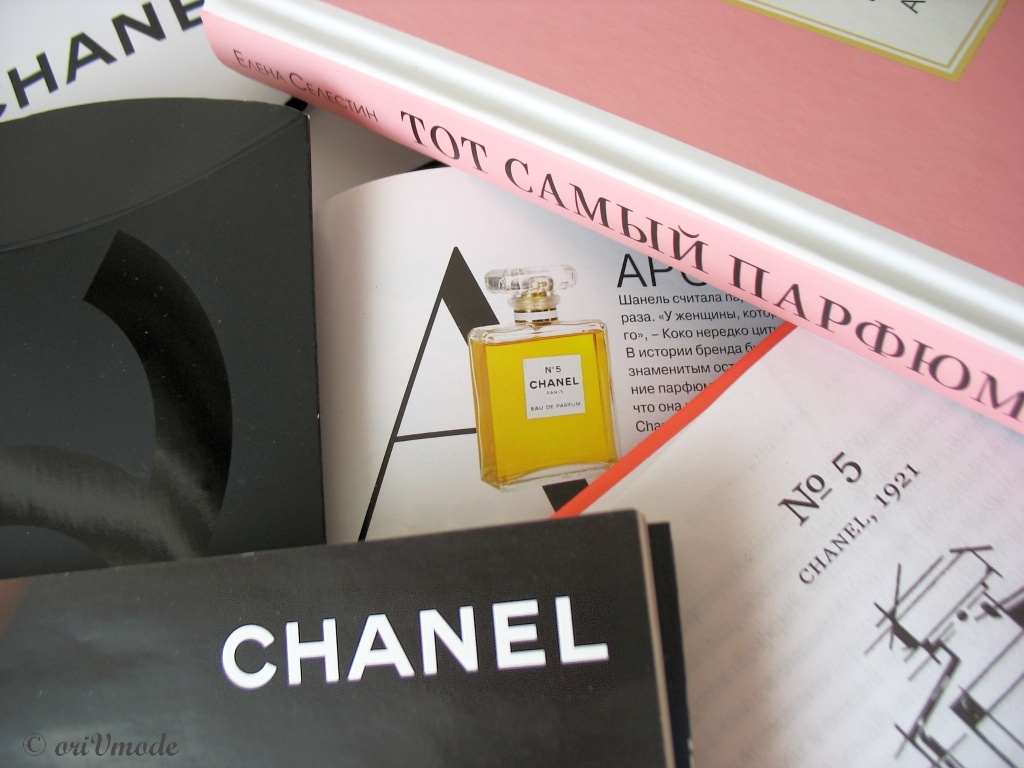
5-го числа 5-го месяца 1921 года, 100 лет назад, в Париже впервые были представлены ставшие впоследствии легендарными духи Chanel №5. Не верится, что история духов, продающихся до сих пор, насчитывает уже целый век.
Как сказано в книге Лиззи Остром «Парфюм. История ароматов ХХ века»:
«Сказать о духах №5 от Chanel что-нибудь оригинальное – это всё равно что попытаться сказать что-то оригинальное о «Гамлете». Об этом парфюме написано столько, что и эту начальную фразу уже наверняка кто-то использовал. №5 – это один из немногих парфюмов, о котором написана отдельная книга. Именно этот парфюм послали бы в космос, если бы появилась такая идея. Именно им пользовалась бы первая женщина из числа тех, кто решился поселиться на Марсе. И его нашли бы при раскопках периода нового железного столетия через много веков после военного апокалипсиса.»
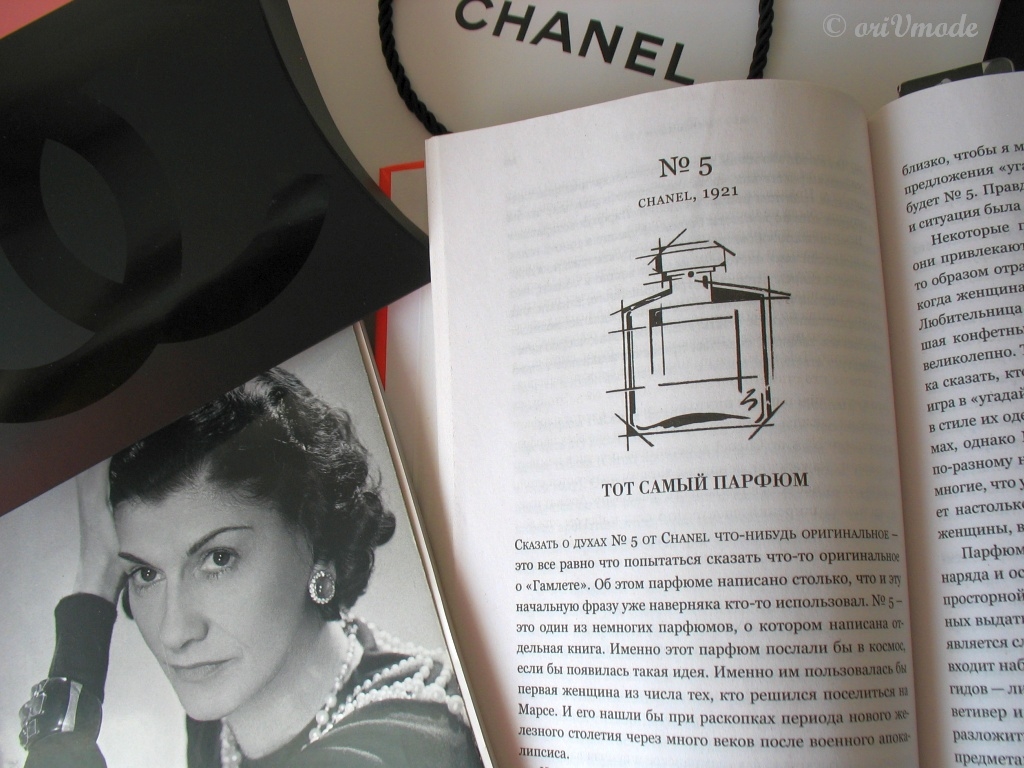
Созданные в двадцатых годах парфюмером российско-французского замеса Эрнестом Эдуардовичем Бо, они стали настоящей революцией и легендой мира парфюмерии.
По легенде Шанель дала парфюмеру, бежавшему из России, такое техзадание (как сказали бы сейчас): «Я хочу создать аромат, который пахнет, как женщина».
Как сказано в книге Елены Селестин «Тот самый парфюм. Завораживающие истории культовых ароматов ХХ века»:
«Чем Chanel №5 поразил клиенток? Революционным в них было всё – название, лаконичный дизайн и прозрачное стекло прямоугольного флакона. А главное удивляла ароматная композиция: главенство альдегидов в верхних нотах парфюмерного аккорда давало ощущение свежести, аромат искрился, был по-новому женственным и остро современным. Словно музыка джаза или живопись кубистов.»
Весь путь аромата овеян легендами и историями. Начиная с выбора Габриэль Шанель образца под номером 5, из вариантов, предложенных на утверждение Эрнестом Бо, так как цифра пять была любима мадемуазель, и свои показы она всегда планировала на 5 мая. Этот номер и дал название духам, что было экстраординарным поступком в те времена.
Выбор прямоугольной формы флакона со скошенными линиями по легенде был сделан в память о туалетных принадлежностях Charvet, которыми любил пользоваться возлюбленный Габриэль Шанель Артур «Бой» Кейпел, трагически погибший в 1919 году.
Крышка флакона была выполнена в виде алмаза, ограненного в форме Вандомской площади в Париже, которая была видна из её номера в отеле Риц.
Согласно материалам журнала RUNWAY MAGAZINE ®
Этот дизайн и его упаковка были зарегистрированы в INPI 6 июля 1923 года. В рекламной брошюре 1924 года Parfums Chanel описывала бутылку как «совершенство продукта запрещает украшать его обычными искусственными средствами. Зачем полагаться на искусство стеклодува… Мадемуазель с гордостью представляет простые флаконы, украшенные только… драгоценными каплями духов несравненного качества, уникальных по составу, раскрывающих творческую индивидуальность их создателя». Этот дизайн бутылки остается неизменным с 1924 года.
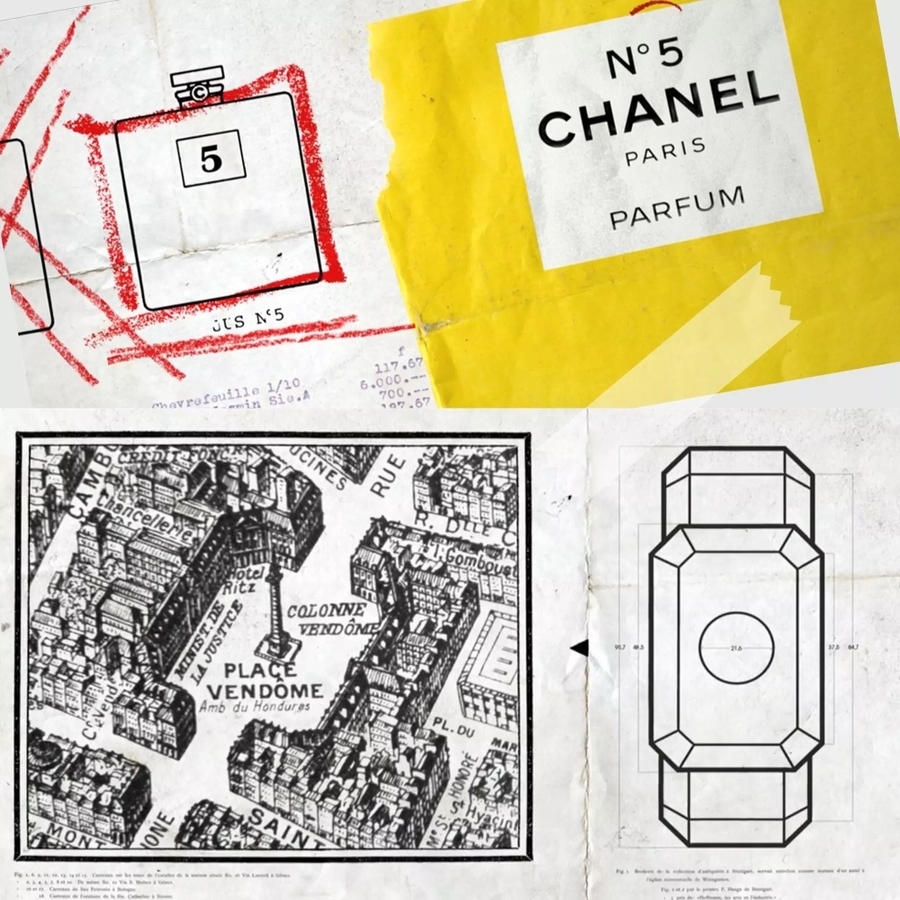
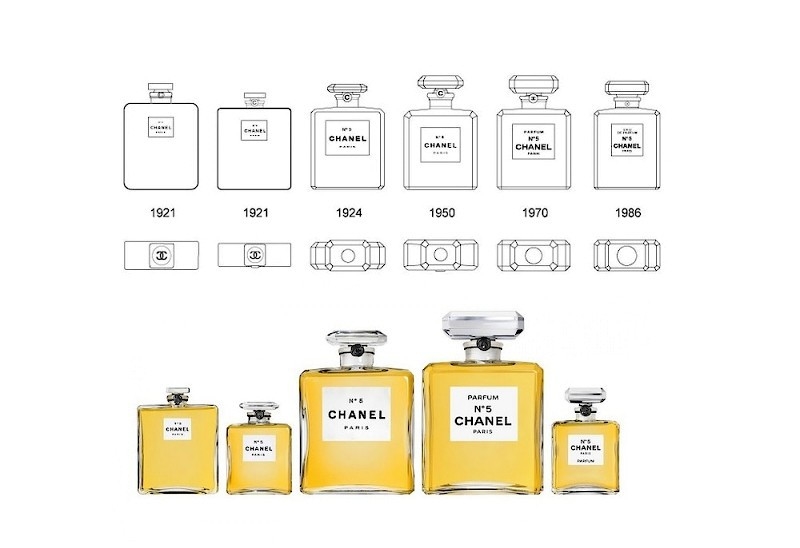
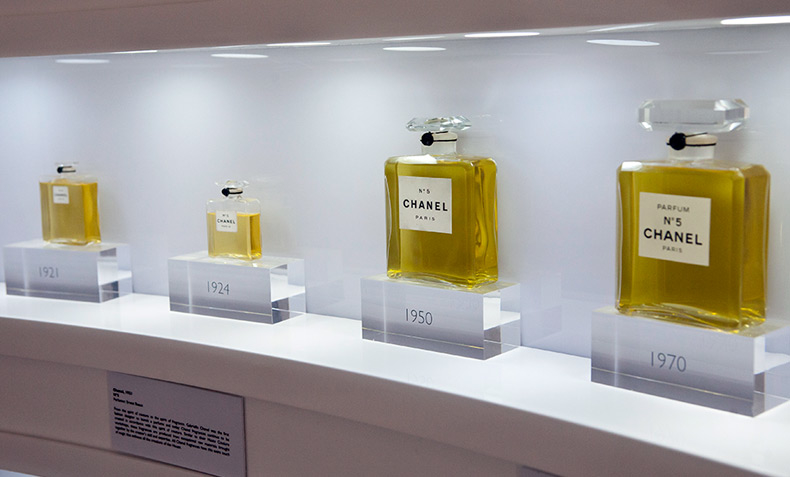
В 1924 Жан Элло разработал тот самый флакон Chanel № 5, который в будущем будет признан всемирно узнаваемым экспонатом (с 1959 года находится в постоянной экспозиции Музея современного искусства в Нью-Йорке).
Знаменитый логотип Chanel также впервые появился на флаконах №5. И история его появления также имеет несколько версий. Кто-то пишет о том, что эти переплетающиеся буквы С напоминали узор витражей в аббатстве Обазин, где росла Габриэль. Кто-то утверждает, что логотип Коко имеет отсылку к монограмме Екатерины Медичи.

.
Недавно на официальном сайте марки был размещен мини-фильм, описывающий век существования легендарных духов: N°5, 100 years of celebrity — Inside CHANEL
.
За прошедшие 100 лет легендарный флакон неоднократно упоминался в книгах, фильмах и даже художественных произведениях.
Например, в 80-х годах знакомые всем очертания можно было встретить на арт-полотнах с шелкографией Энди Уорхола. Также в изображении флакона отметился Сальвадор Дали.
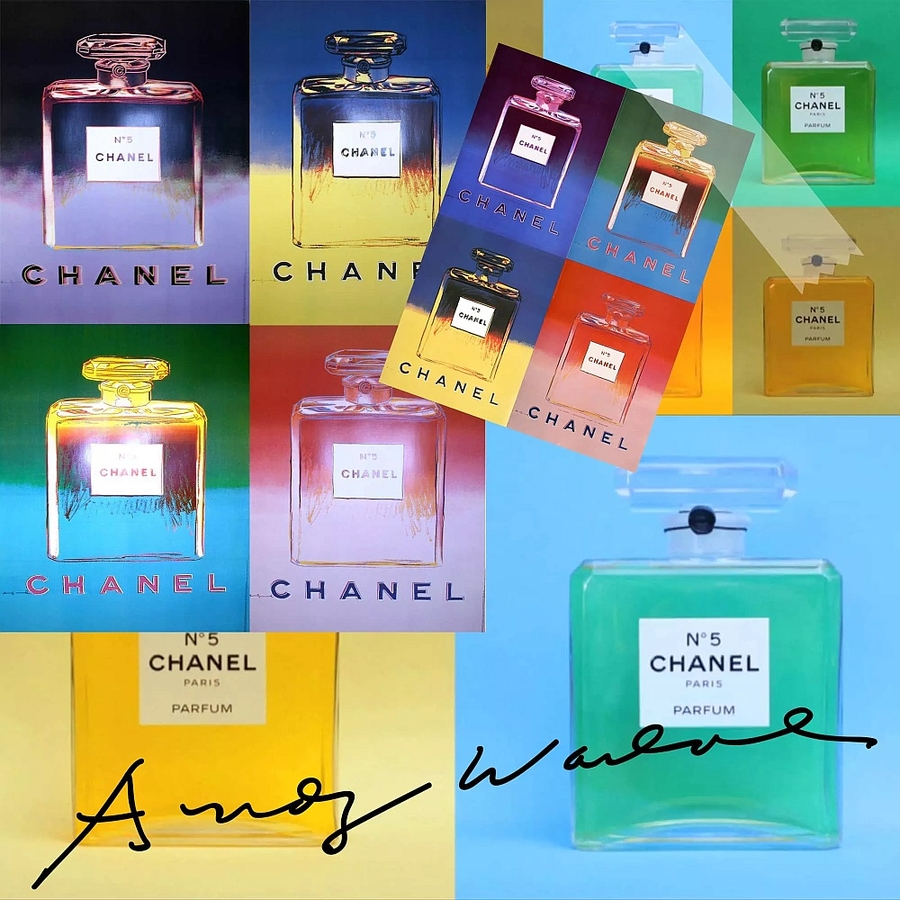
Источник
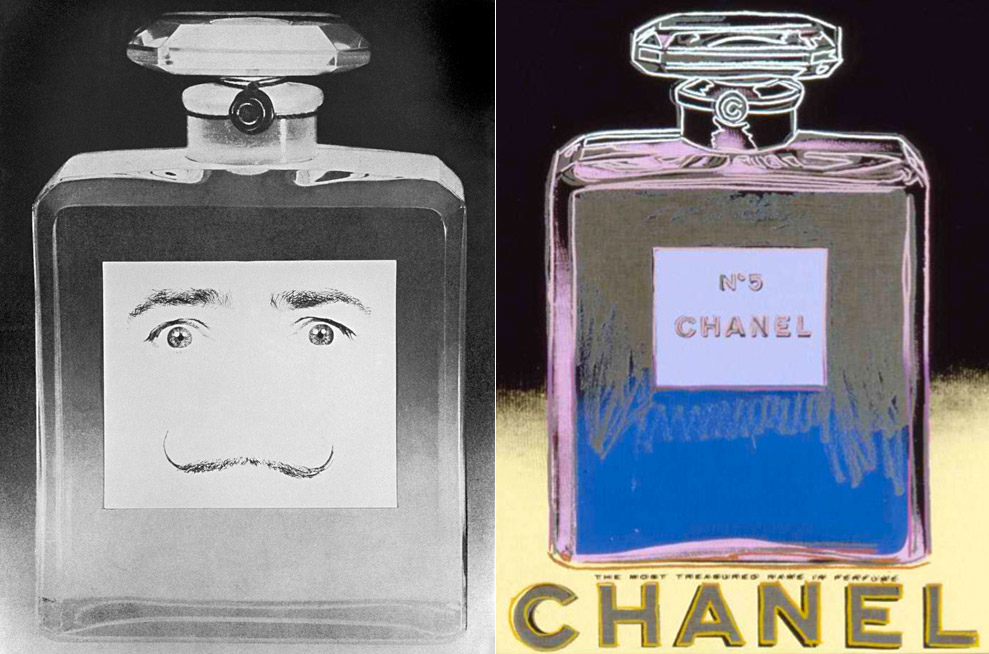
Источник
В кинофильме «Игра в четыре руки» герой Жана-Поля Бельмондо приводит в чувство героиню при помощи знакомого флакона:
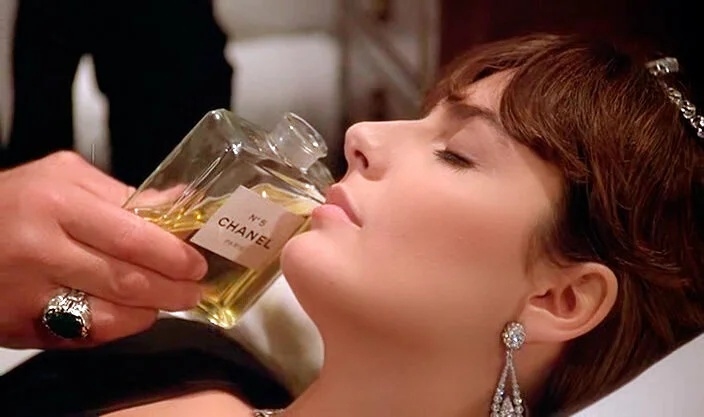
В этом посте я хочу рассказать о рекламных акциях духов Chanel №5 как образцах произведений фото- и киноискусства. Над проектами работали знаменитейшие фотографы и режиссёры. С частью огромного фонда материалов мне и хочется познакомить вас сегодня.
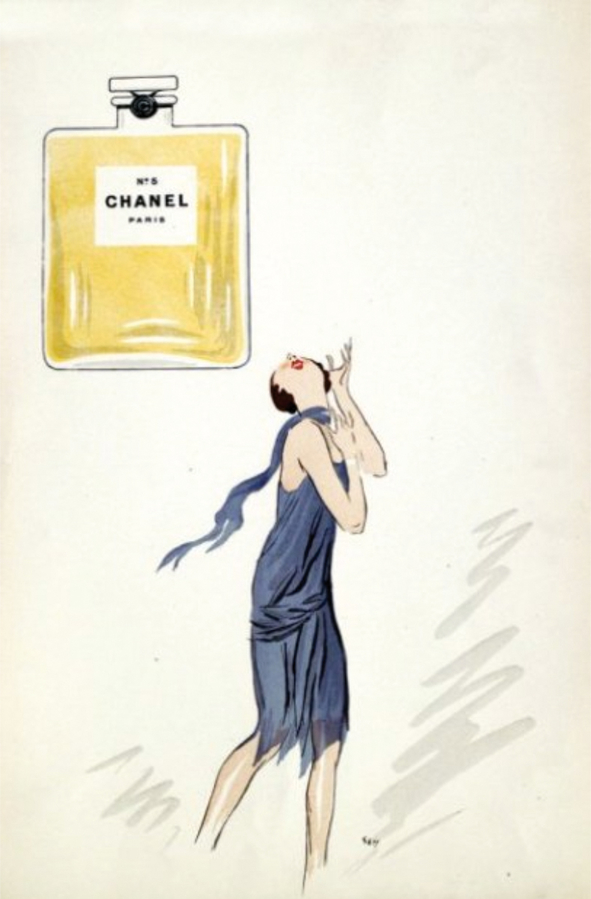
Самой первой моделью для рекламы духов стала сама Коко Шанель, которая позировала в штаб-квартире в отеле Ritz для журнала Harper’s Bazaar в 1937 году (фотограф François Kollar).
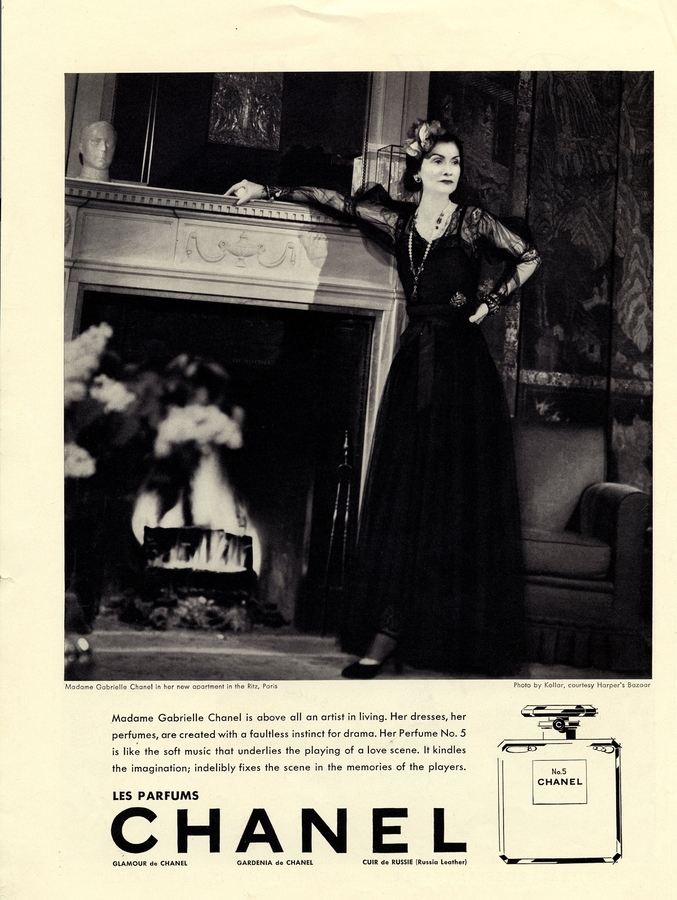
В 50-е годы лицом парфюма стала актриса и модель Сьюзи Паркер, проводившая рекламную кампанию под слоганом: «Каждая живущая на земле женщина любит Chanel №5».
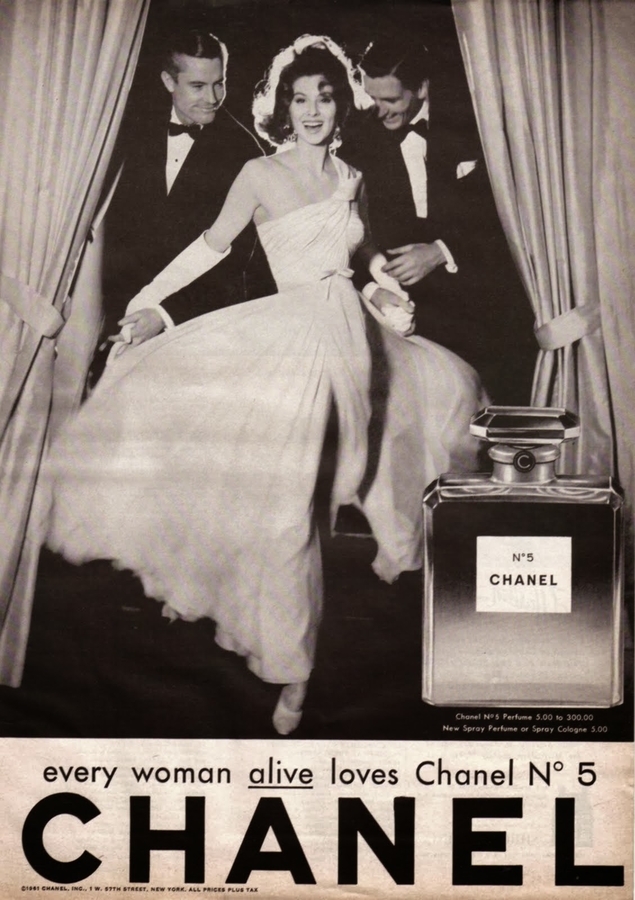
Отдельная глава – рекламные ролики, посвящённые культовому аромату. К их созданию были привлечены многие известнейшие кинорежиссёры и знаменитые актрисы и модели. Предлагаю вашему вниманию обзор этого увлекательного путешествия во времени и пространстве.
Многие годы над роликами Шанель №5 работал знаменитейший режиссёр Ридли Скотт. Ниже вы можете увидеть его работы разных лет.
La Piscine — CHANEL N°5
CHANEL N°5 advertising film from 1979
«La piscine,» by Ridley Scott
© CHANEL 1979
L’Invitation au Rêve — Le Jardin — CHANEL N°5
(нажимайте на стрелку, она рабочая)
CHANEL N°5 advertising film from 1982
«L’invitation au rêve — Le jardin,» by Ridley Scott
© CHANEL 1982
La Star — CHANEL N°5
CHANEL N°5 advertising film from 1990
«La star,» by Ridley Scott, with Carole Bouquet
© CHANEL 1990
This is the first Chanel 5 ad with Carole Bouquet
(American version)
Director Ridley Scott

В 70-х годах над роликами с Катрин Денёв работал знаменитый фотограф и фотохудожник Хельмут Ньютон
Mystery — CHANEL N°5
CHANEL N°5 advertising film from 1977
«Mystery,» by Helmut Newton, with Catherine Deneuve
©CHANEL 1977
Whispered — CHANEL N°5
CHANEL N°5 advertising film from 1973
«Whispered,» by Helmut Newton, with Catherine Deneuve
© CHANEL 1973
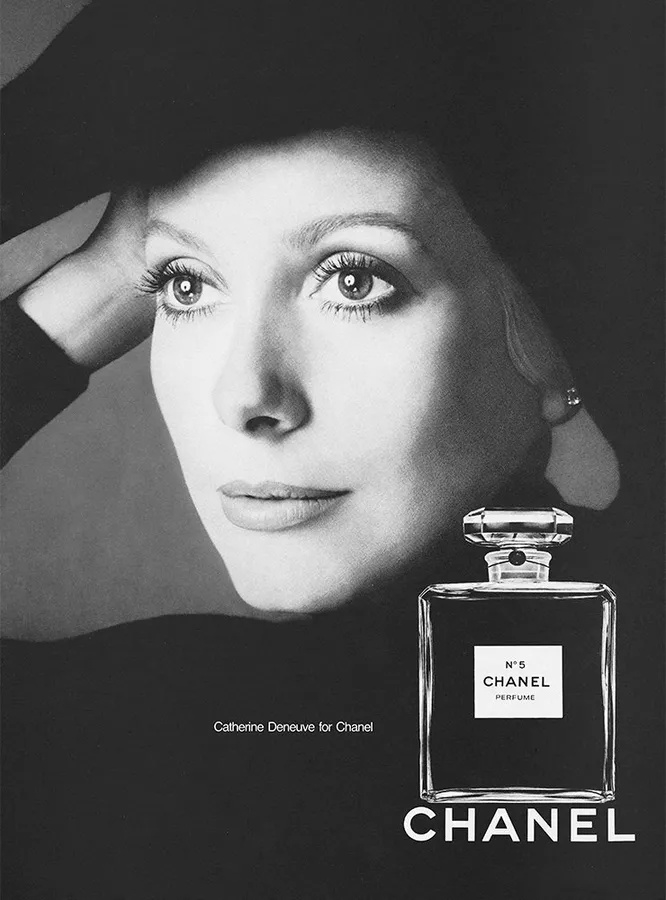
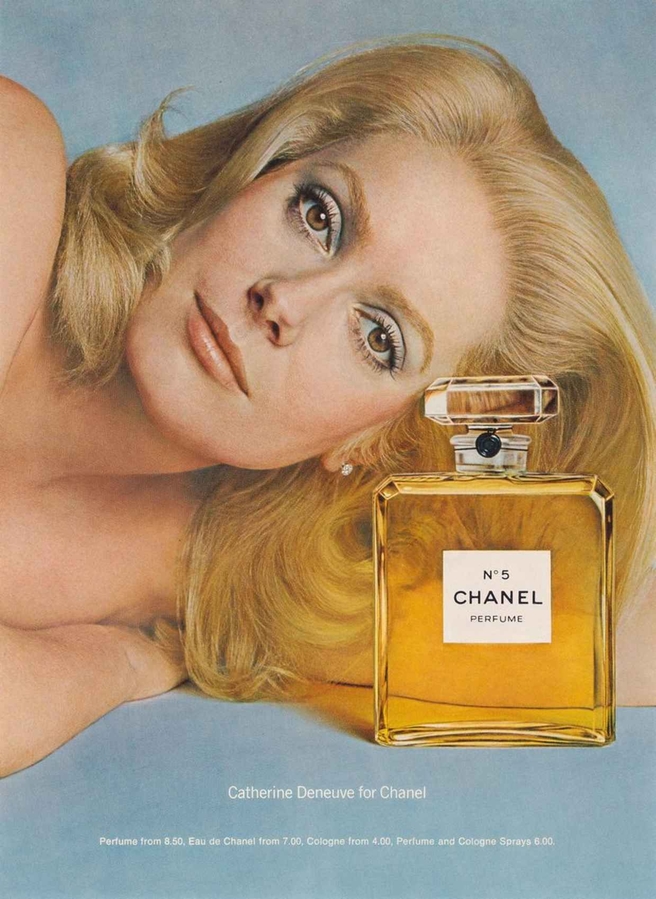
В 90-е годы с уже упомянутым «лицом Шанель №5» — Кароль Буке – работала известный фотограф Беттина Реймс.
Sentiment Troublant — CHANEL N°5
(нажимайте на стрелку, она рабочая)
CHANEL N°5 advertising film from 1993
«Sentiment troublant,» by Bettina Rheims, with Carole Bouquet
© CHANEL 1993
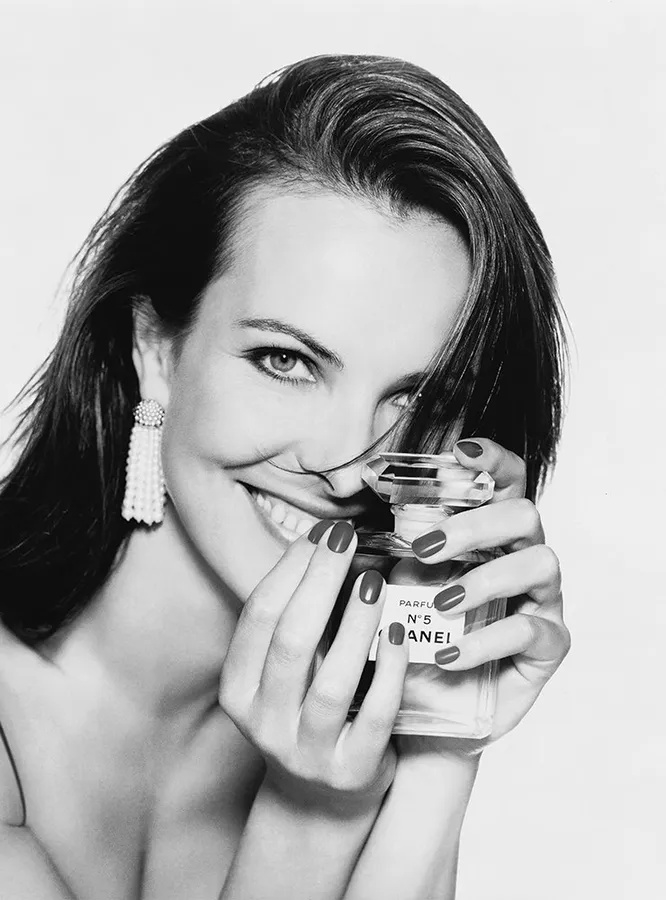
Один из рекламных роликов был снят Люком Бессоном
Le Loup — CHANEL N°5
CHANEL N°5 advertising film from 1998
«Le loup,» by Luc Besson, with Estella Warren
© CHANEL 1998
Одним из удачных рекламных ходов стало использование знаменитого высказывания Мэрилин Монро о том, что на ночь она надевает только несколько капель Шанель №5. В 2012 году на базе найденных неопубликованных ранее аудиозаписей и фотографий кинодивы был создан рекламный видеоролик.
Marilyn and N°5 – Inside CHANEL
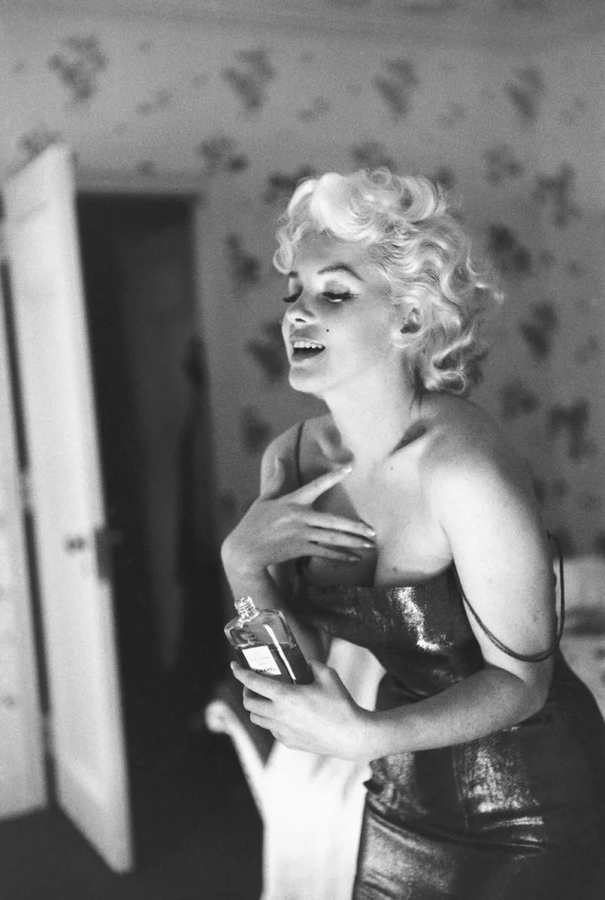
Но не только женские образы были использованы для популяризации легендарного флакона. В том же 2012 году вышло два ролика с участием Брэда Питта, режиссером которых был английский режиссёр Джо Райт (Joe Wright), создатель фильмов «Гордость и предубеждение», «Искупление» и «Анна Каренина». Проникновенный голос актера и его слова в черно-белом формате роликов стали не меньшим магнитом, чем образы знаменитых кинодив.
There you are — CHANEL N°5 Part 1
It’s not a journey… every journey ends.
Discover part one of the new CHANEL N°5 film. Starring Brad Pitt.
Wherever I go — CHANEL N°5 Part 2
Это не путешествие,
ведь любое путешествие заканчивается, а мы идем дальше.
Земля вращается, и мы продолжаем движение вместе с ней.
Планы рушатся, а мечты меняются.
Но куда бы я ни пошел,
ты везде сопровождаешь меня —
мое счастье, моя вера, моя удача.
Chanel № 5 — неизменно.
Источник перевода
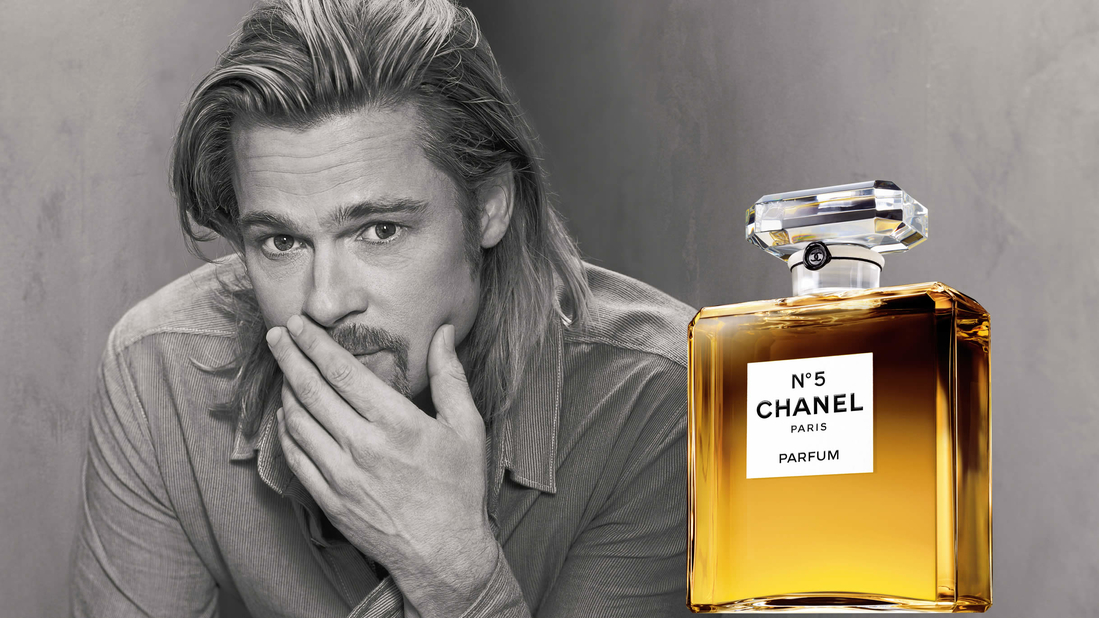
Ну и, наконец, о моих самых любимых трёх мини-фильмах, снятых известными кинорежиссёрами на тему Chanel №5, которые являются на мой вкус рекламными шедеврами и настоящими жемчужинами в искусстве короткого метра.
В 2004 году режиссёром Базом Лурманом был снят красивейший ролик по мотивам фильма «Мулен-Руж», за который он был номинирован на Оскар (за фильм, а не за ролик, хотя он тоже вполне его достоин) с той же Николь Кидман в главной роли. Этот двухминутный фильм стал одним из самых дорогостоящих роликов в истории рекламных видео. По слухам, его бюджет составил 42 миллиона долларов. Примечательно, что сам флакон в мини-фильме так и не появился, но был обозначен логотипом Chanel на колье из 687 бриллиантов, украшающим открытую спину Николь Кидман.
CHANEL N°5, the film with Nicole Kidman – CHANEL Fragrance
CHANEL N°5 advertising film from 2004
«Le Film» by Baz Luhrmann, with Nicole Kidman
© CHANEL 2004
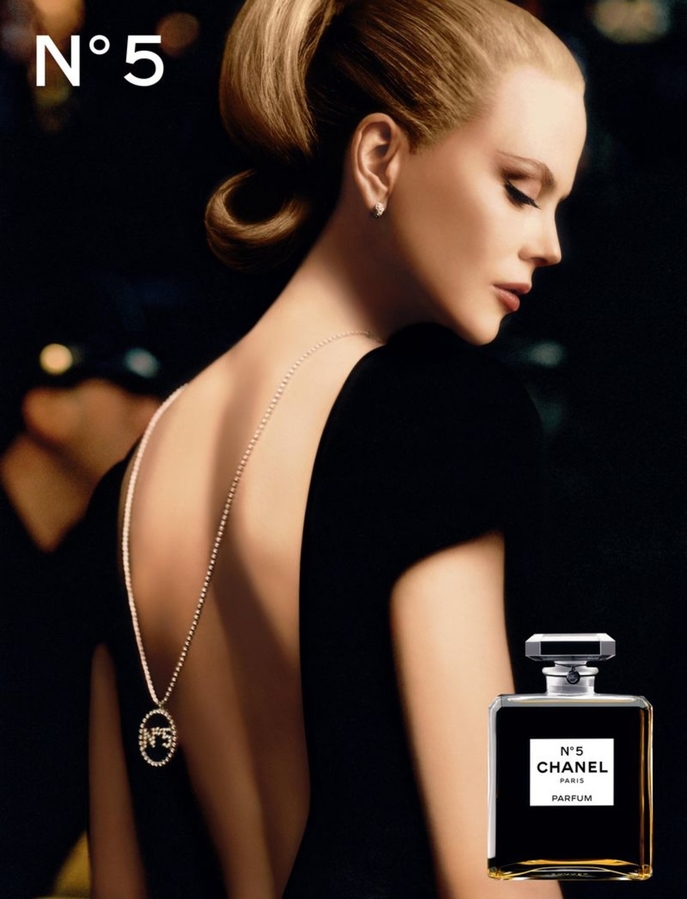
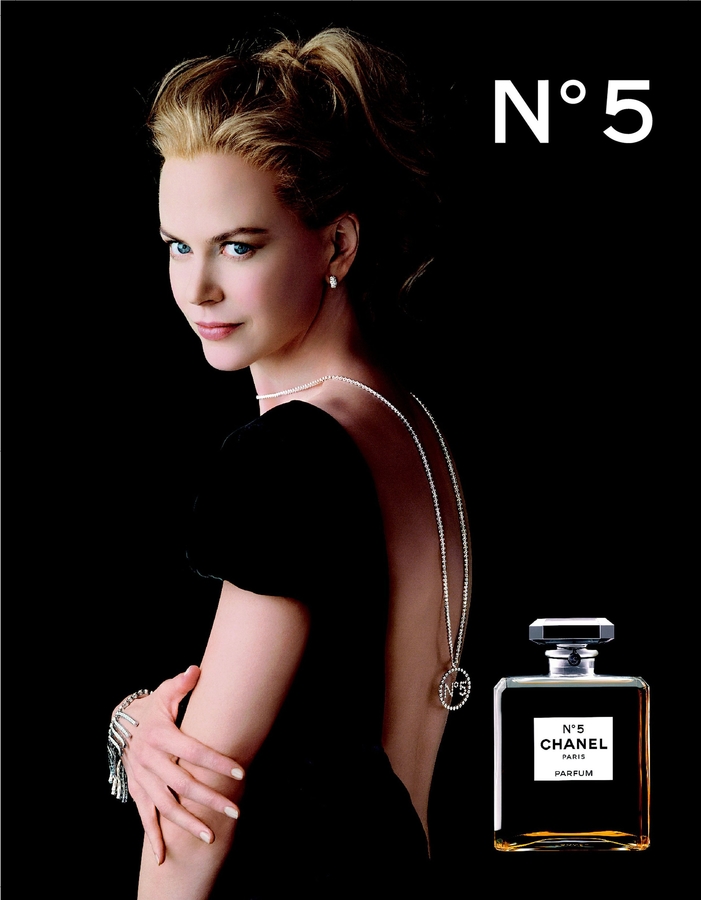
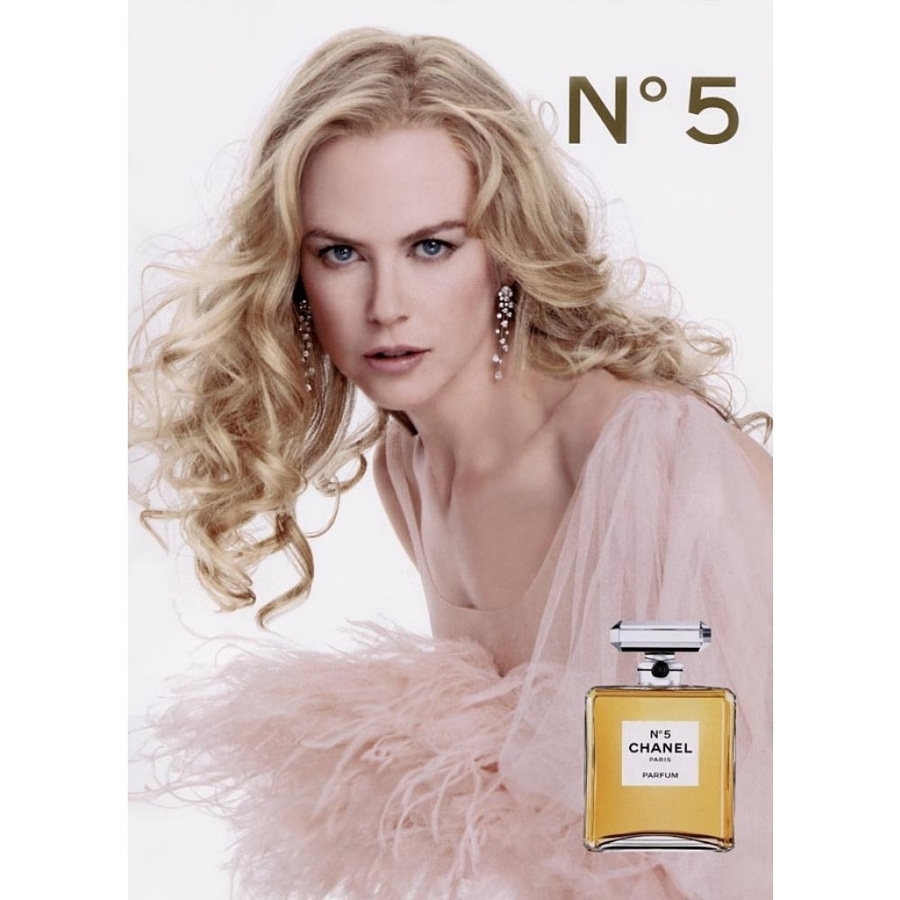
Спустя 10 лет, в 2014 году, вышел ещё один проникновенный 3-х минутный видеоролик, снятый тем же Базом Лурманом. На этот раз в кадре блистали замечательная бразильская супермодель Жизель Бундхен и нидерландский актёр Михиль Хёйсман, известный многим по сериалу «Игра Престолов». Это один из самых моих любимых видеороликов из всех, собранных мною в коллекцию самых красивых реклам парфюмов.
CHANEL N°5: The One That I Want — The Film
A woman, a destiny, a perfume. N°5, the world’s most desirable fragrance.
With Gisele Bündchen, Michiel Huisman and Lo-Fang, directed by Baz Luhrmann.
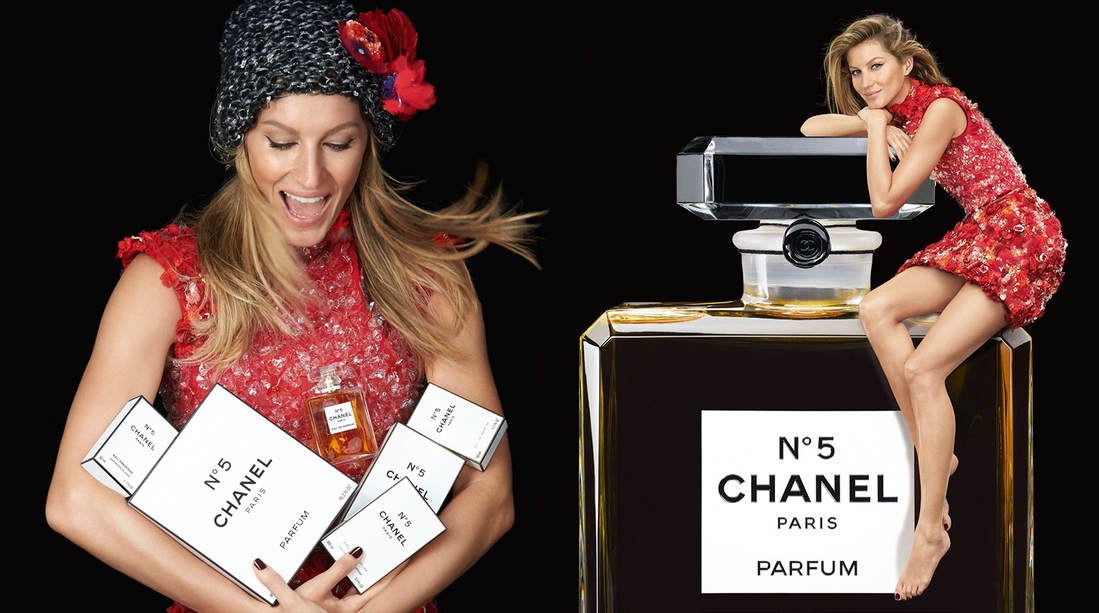
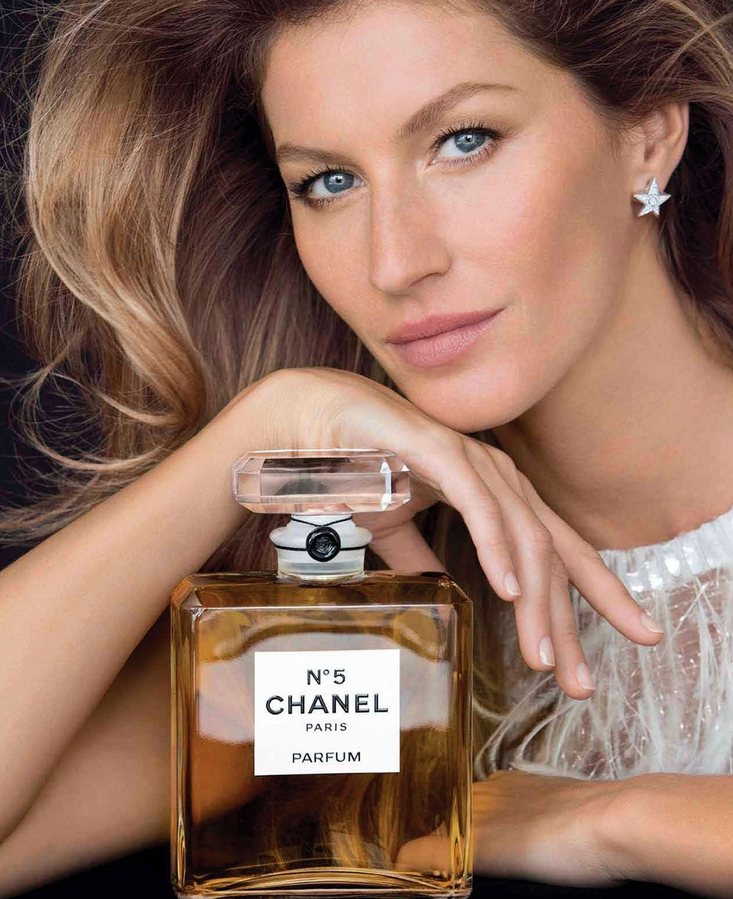
И ещё я обожаю чудесный стильный и атмосферный ролик с Одри Тоту в главной роли и вокалом Билли Холидей, который снял французский кинорежиссёр и сценарист Жан-Пьер Жёне, работавший с Одри Тоту в своём знаменитом фильме «Амели». На тот момент Одри Тоту сыграла молодую Габриэль Шанель в байопике Коко до Шанель, поэтому вполне логично стала впоследствии лицом Chanel №5. И, пожалуй, именно этот ролик для меня символизирует знаменитый флакон. Именно такая атмосфера и история близка для моего понимания этого аромата.
CHANEL N°5, the film Train de Nuit with Audrey Tautou – CHANEL Fragrance
Follow the romantic paths of Audrey Tautou on a night train to Istanbul.
With Audrey Tautou and Travis Davenport, directed by Jean-Pierre Jeunet.
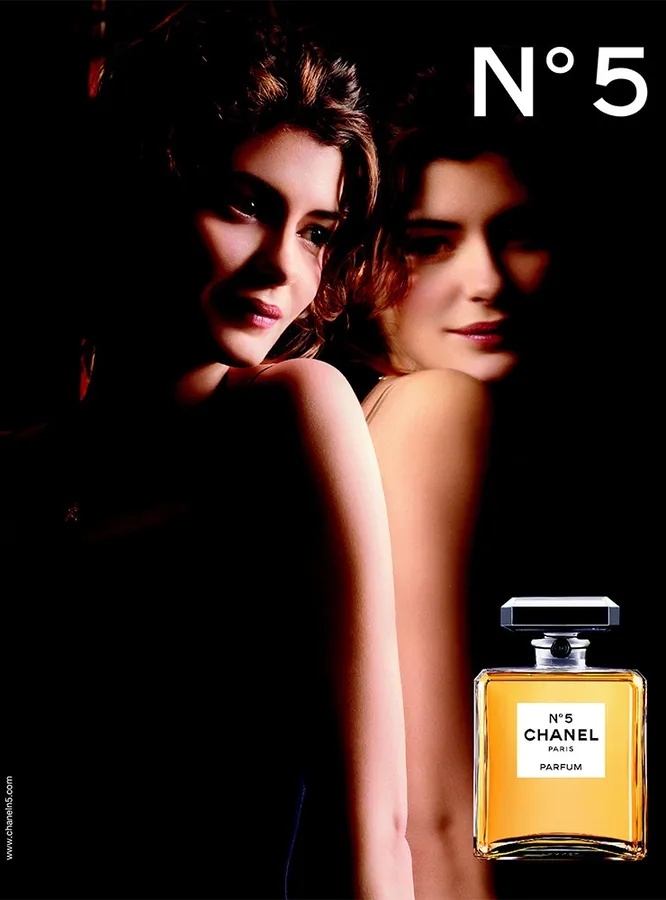
Благодаря этиv трём атмосферным мини-фильмам, при мысли о Chanel №5 в моей памяти всегда всплывают образы, предложенные видением режиссёров — бриллиантовый кулон на открытой спине Николь Кидман, тень флакона в ночном поезде, очень женская история, сыгранная Жизель Бундхен в сопровождении песни Lo-Fang.
После этих трёх, не побоюсь этого слова, шедевров в рекламной истории Шанель №5 случились ролики с Лили-Роуз Депп, снятые к выходу версии L’Eau N°5
L’Eau N°5, the Film with Lily-Rose Depp – CHANEL Fragrance
CHANEL presents the N°5 L’EAU film starring Lily-Rose Depp.
Directed by Johan Renck.
SHAKE UP THE HOLIDAY SPIRIT WITH CHANEL
A film by Jean-Paul Goude featuring Lily-Rose Depp.
К началу празднования столетнего юбилея легендарных духов Chanel №5 в конце 2020 года увидел свет новый мини-фильм, появление которого все ждали, заинтригованные первыми просочившимися кадрами со съёмки. В главной роли танцующей на Луне героини снялась Марион Котийяр, которая продемонстрировала в мини-фильме не только своё актёрское искусство, но и вокал, а также умение танцевать. Ещё одной притягивающей внимание деталью стало роскошное золотое платье, которое отсылает нас к одному из платьев Габриэль. Оно было специально расшито для Марион вручную 16 мастерами Maison Le Sage и скроено так, чтобы она могла в нём танцевать. Обо всех этих тонкостях и секретах съемки можно посмотреть несколько тематических «закадровых» роликов на официальном канале Chanel.
Ну, а теперь, собственно, сам мини-фильм:
N°5. THE FILM — CHANEL Fragrance
N°5. Be a part of what’s to come.
CHANEL presents the N°5 film starring Marion Cotillard and Jérémie Bélingard, directed by Johan Renck.
(p) Chanel 2020
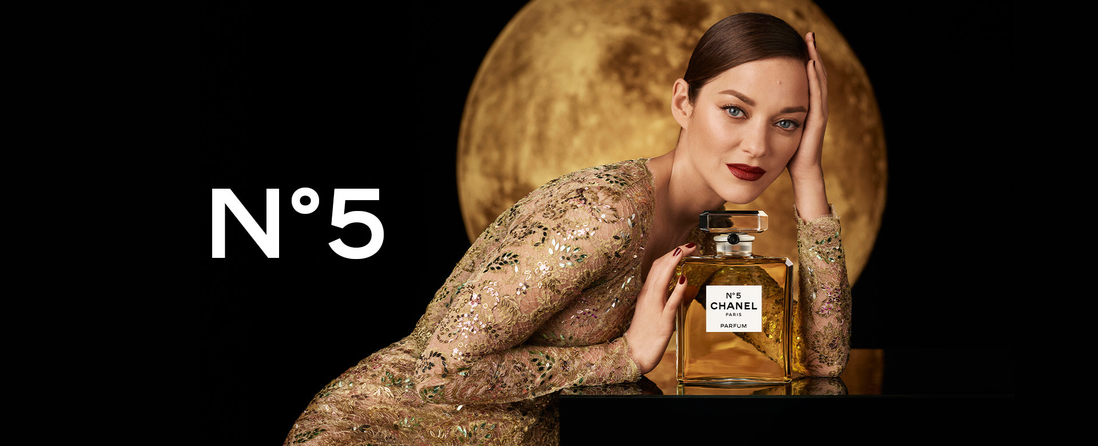

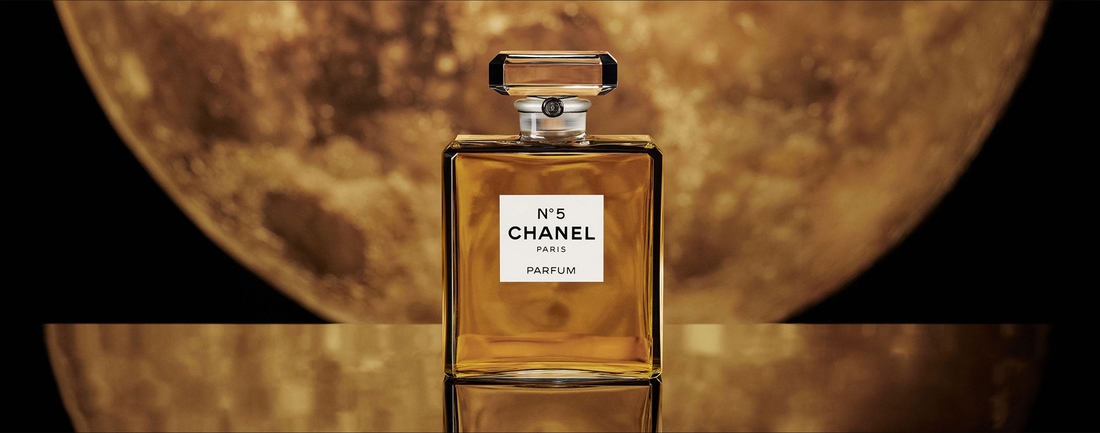
Невозможно уместить 100 лет истории в небольшом рассказе, но приятно полистать самые интересные страницы.
И я буду пересматривать эти ролики ещё много-много раз. А вы?
Для полноты картины привожу описание аромата согласно формату флешмоба:
Chanel N°5 Chanel — это аромат для женщин, принадлежит к группе ароматов цветочные альдегидные. Chanel N°5 выпущен в 1921.
Парфюмер: Ernest Beaux.
Верхние ноты: Альдегиды, Нероли, Иланг, Бергамот, Лимон
Ноты сердца: Корень ириса, Ландыш, Ирис, Жасмин, Роза
Ноты базы: Амбра, Пачули, Циветта, Сандал, Мускус, Ваниль, Дубовый мох, Ветивер
В источниках указывается, что в пирамиде всего более 80 ингредиентов.
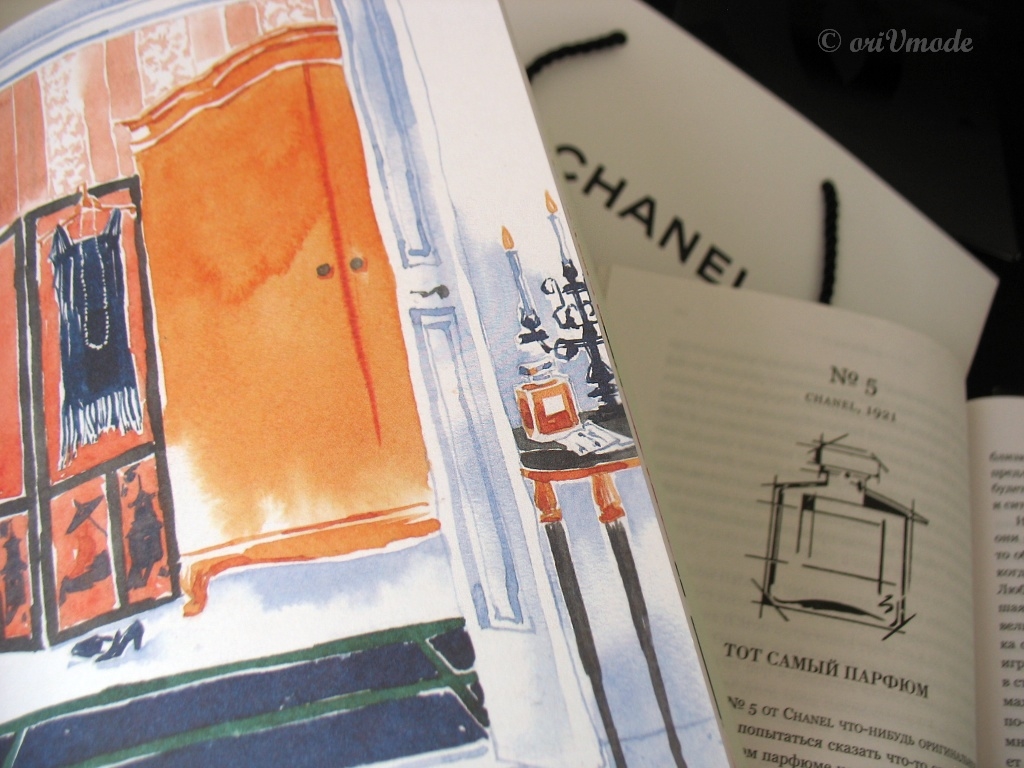
Для меня эти духи уже не просто парфюм, это арт-объект, дыхание эпохи, историческая легенда. Они ассоциируются с изменившимся в 20 веке миром, с целой эпохой развития, с другим взглядом на женские права и потребности, с влиянием отдельной личности и силой идеи, заложенной в простом стеклянном флаконе.
Маленькое чёрное платье и флакон Chanel №5 — это уже классика. Согласны?

https://kosmetista.ru/uploads/images/11/00/81/2021/05/13/59c682.jpg
https://kosmetista.ru/uploads/images/11/00/81/2021/05/13/59c682_lbox.jpg
https://kosmetista.ru/uploads/images/11/00/81/2021/05/13/ede6e1.jpg
https://kosmetista.ru/uploads/images/11/00/81/2021/05/13/ede6e1.jpg
https://kosmetista.ru/uploads/images/11/00/81/2021/05/13/ede6e1_lbox.jpg
https://kosmetista.ru/uploads/images/11/00/81/2021/05/13/bc9dd6.jpg
https://kosmetista.ru/uploads/images/11/00/81/2021/05/13/bc9dd6.jpg
https://kosmetista.ru/uploads/images/11/00/81/2021/05/13/bc9dd6_lbox.jpg
https://kosmetista.ru/uploads/images/11/00/81/2021/05/13/e2c22e.jpg
https://kosmetista.ru/uploads/images/11/00/81/2021/05/13/e2c22e.jpg
https://kosmetista.ru/uploads/images/11/00/81/2021/05/13/e2c22e_lbox.jpg
https://kosmetista.ru/uploads/images/11/00/81/2021/05/14/a051f2.jpg
https://kosmetista.ru/uploads/images/11/00/81/2021/05/14/a051f2.jpg
https://kosmetista.ru/uploads/images/11/00/81/2021/05/14/a051f2_lbox.jpg
https://kosmetista.ru/uploads/images/11/00/81/2021/05/14/217100.jpg
https://kosmetista.ru/uploads/images/11/00/81/2021/05/14/217100.jpg
https://kosmetista.ru/uploads/images/11/00/81/2021/05/14/217100_lbox.jpg
https://kosmetista.ru/uploads/images/11/00/81/2021/05/13/c2d88a.jpg
https://kosmetista.ru/uploads/images/11/00/81/2021/05/13/c2d88a.jpg
https://kosmetista.ru/uploads/images/11/00/81/2021/05/13/c2d88a_lbox.jpg
https://kosmetista.ru/uploads/images/11/00/81/2021/05/13/f1a61c.jpg
https://kosmetista.ru/uploads/images/11/00/81/2021/05/13/f1a61c.jpg
https://kosmetista.ru/uploads/images/11/00/81/2021/05/13/f1a61c_lbox.jpg
https://kosmetista.ru/uploads/images/11/00/81/2021/05/13/d763b7.jpg
https://kosmetista.ru/uploads/images/11/00/81/2021/05/13/d763b7.jpg
https://kosmetista.ru/uploads/images/11/00/81/2021/05/13/d763b7_lbox.jpg
https://kosmetista.ru/uploads/images/11/00/81/2021/05/13/648c85.jpg
https://kosmetista.ru/uploads/images/11/00/81/2021/05/13/648c85.jpg
https://kosmetista.ru/uploads/images/11/00/81/2021/05/13/648c85_lbox.jpg
https://kosmetista.ru/uploads/images/11/00/81/2021/05/13/bd3608.jpg
https://kosmetista.ru/uploads/images/11/00/81/2021/05/13/bd3608.jpg
https://kosmetista.ru/uploads/images/11/00/81/2021/05/13/bd3608_lbox.jpg
https://kosmetista.ru/uploads/images/11/00/81/2021/05/13/ed40d3.jpg
https://kosmetista.ru/uploads/images/11/00/81/2021/05/13/ed40d3.jpg
https://kosmetista.ru/uploads/images/11/00/81/2021/05/13/ed40d3_lbox.jpg
https://kosmetista.ru/uploads/images/11/00/81/2021/05/13/019fd6.jpg
https://kosmetista.ru/uploads/images/11/00/81/2021/05/13/019fd6.jpg
https://kosmetista.ru/uploads/images/11/00/81/2021/05/13/019fd6_lbox.jpg
https://kosmetista.ru/uploads/images/11/00/81/2021/05/13/9e026a.jpg
https://kosmetista.ru/uploads/images/11/00/81/2021/05/13/9e026a.jpg
https://kosmetista.ru/uploads/images/11/00/81/2021/05/13/9e026a_lbox.jpg
https://kosmetista.ru/uploads/images/11/00/81/2021/05/13/b64da7.jpg
https://kosmetista.ru/uploads/images/11/00/81/2021/05/13/b64da7.jpg
https://kosmetista.ru/uploads/images/11/00/81/2021/05/13/b64da7_lbox.jpg
https://kosmetista.ru/uploads/images/11/00/81/2021/05/13/c7a086.jpg
https://kosmetista.ru/uploads/images/11/00/81/2021/05/13/c7a086.jpg
https://kosmetista.ru/uploads/images/11/00/81/2021/05/13/c7a086_lbox.jpg
https://kosmetista.ru/uploads/images/11/00/81/2021/05/13/531cc7.jpg
https://kosmetista.ru/uploads/images/11/00/81/2021/05/13/531cc7.jpg
https://kosmetista.ru/uploads/images/11/00/81/2021/05/13/531cc7_lbox.jpg
https://kosmetista.ru/uploads/images/11/00/81/2021/05/13/4b90df.jpg
https://kosmetista.ru/uploads/images/11/00/81/2021/05/13/4b90df.jpg
https://kosmetista.ru/uploads/images/11/00/81/2021/05/13/4b90df_lbox.jpg
https://kosmetista.ru/uploads/images/11/00/81/2021/05/13/2eb84a.jpg
https://kosmetista.ru/uploads/images/11/00/81/2021/05/13/2eb84a.jpg
https://kosmetista.ru/uploads/images/11/00/81/2021/05/13/2eb84a_lbox.jpg
https://kosmetista.ru/uploads/images/11/00/81/2021/05/13/5ef825.jpg
https://kosmetista.ru/uploads/images/11/00/81/2021/05/13/5ef825.jpg
https://kosmetista.ru/uploads/images/11/00/81/2021/05/13/5ef825_lbox.jpg
https://kosmetista.ru/uploads/images/11/00/81/2021/05/13/cff830.jpg
https://kosmetista.ru/uploads/images/11/00/81/2021/05/13/cff830.jpg
https://kosmetista.ru/uploads/images/11/00/81/2021/05/13/cff830_lbox.jpg
https://kosmetista.ru/uploads/images/11/00/81/2021/05/13/ff936b.jpg
https://kosmetista.ru/uploads/images/11/00/81/2021/05/13/ff936b.jpg
https://kosmetista.ru/uploads/images/11/00/81/2021/05/13/ff936b_lbox.jpg
https://kosmetista.ru/uploads/images/11/00/81/2021/05/13/b79306.jpg
https://kosmetista.ru/uploads/images/11/00/81/2021/05/13/b79306.jpg
https://kosmetista.ru/uploads/images/11/00/81/2021/05/13/b79306_lbox.jpg
https://kosmetista.ru/uploads/images/11/00/81/2021/05/13/16f512.jpg
https://kosmetista.ru/uploads/images/11/00/81/2021/05/13/16f512.jpg
https://kosmetista.ru/uploads/images/11/00/81/2021/05/13/16f512_lbox.jpg
https://kosmetista.ru/uploads/images/11/00/81/2021/05/13/b6ff1a.jpg
https://kosmetista.ru/uploads/images/11/00/81/2021/05/13/b6ff1a.jpg
https://kosmetista.ru/uploads/images/11/00/81/2021/05/13/b6ff1a_lbox.jpg
https://kosmetista.ru/uploads/images/11/00/81/2021/05/13/270ff5.jpg
https://kosmetista.ru/uploads/images/11/00/81/2021/05/13/270ff5.jpg
https://kosmetista.ru/uploads/images/11/00/81/2021/05/13/270ff5_lbox.jpg
https://kosmetista.ru/uploads/images/11/00/81/2021/05/13/c476ee.jpg
https://kosmetista.ru/uploads/images/11/00/81/2021/05/13/c476ee.jpg
https://kosmetista.ru/uploads/images/11/00/81/2021/05/13/c476ee_lbox.jpg
https://kosmetista.ru/uploads/images/11/00/81/2021/05/13/4596f2.jpg
https://kosmetista.ru/uploads/images/11/00/81/2021/05/13/4596f2.jpg
https://kosmetista.ru/uploads/images/11/00/81/2021/05/13/4596f2_lbox.jpg
Лучшее за месяц
Вход
Говорят, ничто не вечно. Однако есть шедевры, которые остаются в веках. Именно к таким легендам и относится аромат «Chanel №5. Несмотря на то, что он был создан еще в первой половине прошлого века, эти духи являются одними из самых популярных в наши дни.
В мире до сих пор ежеминутно покупают один флакон «Chanel №5». Этот аромат поистине стал символом XX века.

Как же создавался этот легендарный парфюм? История духов «Chanel №5» насыщена интересными событиями. Для начала, необходимо сказать несколько слов о парфюмерном искусстве того времени. Тогда для изготовления ароматов использовались натуральные экстракты цветов. В связи с этим каждый отдельно взятый аромат не отличался особой стойкостью и был похож на запах того или иного цветка. Именно по этой причине Коко Шанель не особо интересовалась созданием собственного аромата. Однако со временем она поменяла свое мнение.

Все началось с того, как Дмитрий Романов (представитель династии Романовых, внук Александра II), будучи фаворитом Габриэль Шанель, познакомил ее с Бо Эрнестом Эдуардовичем, который ранее занимал должность придворного парфюмера династии Романовых. В 1918 году Бо эмигрировал в французский город Грассе, где работал на старейшей парфюмерной фабрике «А. Ралле и Ко», основанной еще в середине XIX века. Эрнест Бо знакомит Коко Шанель с альдегидами, после чего она решается на создание собственного аромата. Бо берется за работу.
В результате в 1921 году он предложил Габриэль Шанель несколько ароматов, каждый из которых был пронумерован. Из всех предложенных пробников, Коко выбирает образец под номером 5. Он представлял собой совершенно новый, ни на что непохожий аромат. В его состав входило около восьмидесяти ингредиентов. Шанель была довольна результатом, она получила именно то, что ожидала от Эрнеста Бо.

Все ароматы того времени имели довольно сложные названия, однако Коко известна всему миру как женщина, которая не боялась ломать стереотипы. Она решила назвать духи своим именем и добавила к нему цифру пять – номер, под которым аромат был ей предложен Эрнестом Бо. Так в истории появились легендарные духи Chanel №5.

Внешний вид флакона также был весьма необычным для того времени. Как правило, духи продавались в хрустальных пузырьках сложных форм, украшенных золотом и драгоценными камнями. Однако это совершенно не соответствовало образу Габриэль Шанель. Она и здесь проявила новаторство, выбрав для своего аромата стеклянный флакон прямоугольной формы. Тогда подобные флаконы использовали для мужских духов. Это было очень смелое решение для того времени. В 1924 году была предпринята попытка изменить форму флакона – несколько закруглить края и изменить пробку, однако Коко быстро пресекла эту попытку и оставила неизменным дизайн флакона.

Интересен и способ, который выбрала Габриэль, чтобы повысить интерес к новому аромату. Она подарила духи нескольким своим подругам, которые, вращаясь в самых изысканных кругах, сделали тем самым наилучшую рекламу новому аромату. В результате образовался тайный клуб поклонниц духов Chanel №5. Только после этого Коко Шанель выпускает свой аромат в продажу, вызвав тем самым бешеный ажиотаж вокруг этого события.

Формула Chanel №5 осталась неизменной с момента ее создания. В ее состав входят экстракты лимона, бергамота, ириса, жасмина, ландыша, розы, а также корень фиалки, альдегиды, иланг-иланг, мускус, ваниль, пачули, сандаловое дерево, амбра, виверра и еще множество других ингредиентов. Интерес к аромату Chanel №5 не ослабевает и сегодня. Эти поистине легендарные духи находят своих новых почитателей.
